Similar presentations:
The Market Forces of Supply and Demand
1.
SUPPLY AND DEMAND I: HOW MARKETS WORK2.
The Market Forces ofSupply and Demand
Copyright © 2004 South-Western
3.
• Supply and demand are the two words thateconomists use most often.
• Supply and demand are the forces that make
market economies work.
• Modern microeconomics is about supply,
demand, and market equilibrium.
Copyright © 2004 South-Western
4. MARKETS AND COMPETITION
• A market is a group of buyers and sellers of aparticular good or service.
• The terms supply and demand refer to the
behavior of people . . . as they interact with one
another in markets.
Copyright © 2004 South-Western
5. MARKETS AND COMPETITION
• Buyers determine demand.• Sellers determine supply
Copyright © 2004 South-Western
6. Competitive Markets
• A competitive market is a market in which thereare many buyers and sellers so that each has a
negligible impact on the market price.
Copyright © 2004 South-Western
7. Competition: Perfect and Otherwise
• Perfect Competition• Products are the same
• Numerous buyers and sellers so that each has no
influence over price
• Buyers and Sellers are price takers
• Monopoly
• One seller, and seller controls price
Copyright © 2004 South-Western
8. Competition: Perfect and Otherwise
• Oligopoly• Few sellers
• Not always aggressive competition
• Monopolistic Competition
• Many sellers
• Slightly differentiated products
• Each seller may set price for its own product
Copyright © 2004 South-Western
9. DEMAND
• Quantity demanded is the amount of a good thatbuyers are willing and able to purchase.
• Law of Demand
• The law of demand states that, other things equal,
the quantity demanded of a good falls when the
price of the good rises.
Copyright © 2004 South-Western
10. The Demand Curve: The Relationship between Price and Quantity Demanded
• Demand Schedule• The demand schedule is a table that shows the
relationship between the price of the good and the
quantity demanded.
Copyright © 2004 South-Western
11. Catherine’s Demand Schedule
Copyright © 2004 South-Western12. The Demand Curve: The Relationship between Price and Quantity Demanded
• Demand Curve• The demand curve is a graph of the relationship
between the price of a good and the quantity
demanded.
Copyright © 2004 South-Western
13. Figure 1 Catherine’s Demand Schedule and Demand Curve
Price ofIce-Cream Cone
$3.00
2.50
1. A decrease
in price ...
2.00
1.50
1.00
0.50
0 1 2 3 4 5 6 7 8 9 10 11 12 Quantity of
Ice-Cream Cones
2. ... increases quantity
of cones demanded.
Copyright © 2004 South-Western
14. Market Demand versus Individual Demand
• Market demand refers to the sum of allindividual demands for a particular good or
service.
• Graphically, individual demand curves are
summed horizontally to obtain the market
demand curve.
Copyright © 2004 South-Western
15. Shifts in the Demand Curve
• Change in Quantity Demanded• Movement along the demand curve.
• Caused by a change in the price of the product.
Copyright © 2004 South-Western
16. Changes in Quantity Demanded
Price of IceCreamCones
B
$2.00
A tax that raises the
price of ice-cream
cones results in a
movement along the
demand curve.
A
1.00
D
0
4
8
Quantity of Ice-Cream Cones
Copyright © 2004 South-Western
17. Shifts in the Demand Curve
Consumer income
Prices of related goods
Tastes
Expectations
Number of buyers
Copyright © 2004 South-Western
18. Shifts in the Demand Curve
• Change in Demand• A shift in the demand curve, either to the left or
right.
• Caused by any change that alters the quantity
demanded at every price.
Copyright © 2004 South-Western
19. Figure 3 Shifts in the Demand Curve
Price ofIce-Cream
Cone
Increase
in demand
Decrease
in demand
Demand
curve, D2
Demand
curve, D1
Demand curve, D3
0
Quantity of
Ice-Cream Cones
Copyright©2003 Southwestern/Thomson Learning
20. Shifts in the Demand Curve
• Consumer Income• As income increases the demand for a normal good
will increase.
• As income increases the demand for an inferior
good will decrease.
Copyright © 2004 South-Western
21. Consumer Income Normal Good
Price of IceCream Cone$3.00
An increase
in income...
2.50
Increase
in demand
2.00
1.50
1.00
0.50
D1
0 1
2 3 4 5 6 7 8 9 10 11 12
D2
Quantity of
Ice-Cream
Cones
Copyright © 2004 South-Western
22. Consumer Income Inferior Good
Price of IceCream Cone$3.00
2.50
An increase
in income...
2.00
Decrease
in demand
1.50
1.00
0.50
D2
0 1
D1
2 3 4 5 6 7 8 9 10 11 12
Quantity of
Ice-Cream
Cones
Copyright © 2004 South-Western
23. Shifts in the Demand Curve
• Prices of Related Goods• When a fall in the price of one good reduces the
demand for another good, the two goods are called
substitutes.
• When a fall in the price of one good increases the
demand for another good, the two goods are called
complements.
Copyright © 2004 South-Western
24. Table 1 Variables That Influence Buyers
Copyright©2004 South-Western25. SUPPLY
• Quantity supplied is the amount of a good thatsellers are willing and able to sell.
• Law of Supply
• The law of supply states that, other things equal, the
quantity supplied of a good rises when the price of
the good rises.
Copyright © 2004 South-Western
26. The Supply Curve: The Relationship between Price and Quantity Supplied
• Supply Schedule• The supply schedule is a table that shows the
relationship between the price of the good and the
quantity supplied.
Copyright © 2004 South-Western
27. Ben’s Supply Schedule
Copyright © 2004 South-Western28. The Supply Curve: The Relationship between Price and Quantity Supplied
• Supply Curve• The supply curve is the graph of the relationship
between the price of a good and the quantity
supplied.
Copyright © 2004 South-Western
29. Figure 5 Ben’s Supply Schedule and Supply Curve
Price ofIce-Cream
Cone
$3.00
1. An
increase
in price ...
2.50
2.00
1.50
1.00
0.50
0
1 2
3
4
5
6
7
8
9 10 11 12 Quantity of
Ice-Cream Cones
2. ... increases quantity of cones supplied.
Copyright©2003 Southwestern/Thomson Learning
30. Market Supply versus Individual Supply
• Market supply refers to the sum of allindividual supplies for all sellers of a particular
good or service.
• Graphically, individual supply curves are
summed horizontally to obtain the market
supply curve.
Copyright © 2004 South-Western
31. Shifts in the Supply Curve
Input prices
Technology
Expectations
Number of sellers
Copyright © 2004 South-Western
32. Shifts in the Supply Curve
• Change in Quantity Supplied• Movement along the supply curve.
• Caused by a change in anything that alters the
quantity supplied at each price.
Copyright © 2004 South-Western
33. Change in Quantity Supplied
Price of IceCreamCone
S
C
$3.00
A rise in the price
of ice cream
cones results in a
movement along
the supply curve.
A
1.00
0
1
5
Quantity of
Ice-Cream
Cones
Copyright © 2004 South-Western
34. Shifts in the Supply Curve
• Change in Supply• A shift in the supply curve, either to the left or right.
• Caused by a change in a determinant other than
price.
Copyright © 2004 South-Western
35. Figure 7 Shifts in the Supply Curve
Price ofIce-Cream
Cone
Supply curve, S3
Decrease
in supply
Supply
curve, S1
Supply
curve, S2
Increase
in supply
0
Quantity of
Ice-Cream Cones
Copyright©2003 Southwestern/Thomson Learning
36. Table 2 Variables That Influence Sellers
Copyright©2004 South-Western37. SUPPLY AND DEMAND TOGETHER
• Equilibrium refers to a situation in which theprice has reached the level where quantity
supplied equals quantity demanded.
Copyright © 2004 South-Western
38. SUPPLY AND DEMAND TOGETHER
• Equilibrium Price• The price that balances quantity supplied and
quantity demanded.
• On a graph, it is the price at which the supply and
demand curves intersect.
• Equilibrium Quantity
• The quantity supplied and the quantity demanded at
the equilibrium price.
• On a graph it is the quantity at which the supply and
demand curves intersect.
Copyright © 2004 South-Western
39. SUPPLY AND DEMAND TOGETHER
Demand ScheduleSupply Schedule
At $2.00, the quantity demanded
is equal to the quantity supplied!
Copyright © 2004 South-Western
40. Figure 8 The Equilibrium of Supply and Demand
Price ofIce-Cream
Cone
Supply
Equilibrium
Equilibrium price
$2.00
Equilibrium
quantity
0
1
2
3
4
5
6
7
8
Demand
9 10 11 12 13
Quantity of Ice-Cream Cones
Copyright©2003 Southwestern/Thomson Learning
41. Figure 9 Markets Not in Equilibrium
(a) Excess SupplyPrice of
Ice-Cream
Cone
Supply
Surplus
$2.50
2.00
Demand
0
4
Quantity
demanded
7
10
Quantity
supplied
Quantity of
Ice-Cream
Cones
Copyright©2003 Southwestern/Thomson Learning
42. Equilibrium
• Surplus• When price > equilibrium price, then quantity
supplied > quantity demanded.
• There is excess supply or a surplus.
• Suppliers will lower the price to increase sales, thereby
moving toward equilibrium.
Copyright © 2004 South-Western
43. Equilibrium
• Shortage• When price < equilibrium price, then quantity
demanded > the quantity supplied.
• There is excess demand or a shortage.
• Suppliers will raise the price due to too many buyers
chasing too few goods, thereby moving toward
equilibrium.
Copyright © 2004 South-Western
44. Figure 9 Markets Not in Equilibrium
(b) Excess DemandPrice of
Ice-Cream
Cone
Supply
$2.00
1.50
Shortage
Demand
0
4
Quantity
supplied
7
10
Quantity of
Quantity
Ice-Cream
demanded
Cones
Copyright©2003 Southwestern/Thomson Learning
45. Equilibrium
• Law of supply and demand• The claim that the price of any good adjusts to bring
the quantity supplied and the quantity demanded for
that good into balance.
Copyright © 2004 South-Western
46. Three Steps to Analyzing Changes in Equilibrium
• Decide whether the event shifts the supply ordemand curve (or both).
• Decide whether the curve(s) shift(s) to the left
or to the right.
• Use the supply-and-demand diagram to see how
the shift affects equilibrium price and quantity.
Copyright © 2004 South-Western
47. Figure 10 How an Increase in Demand Affects the Equilibrium
Price ofIce-Cream
Cone
1. Hot weather increases
the demand for ice cream . . .
Supply
New equilibrium
$2.50
2.00
2. . . . resulting
in a higher
price . . .
Initial
equilibrium
D
D
0
7
3. . . . and a higher
quantity sold.
10
Quantity of
Ice-Cream Cones
Copyright©2003 Southwestern/Thomson Learning
48. Three Steps to Analyzing Changes in Equilibrium
• Shifts in Curves versus Movements alongCurves
• A shift in the supply curve is called a change in
supply.
• A movement along a fixed supply curve is called a
change in quantity supplied.
• A shift in the demand curve is called a change in
demand.
• A movement along a fixed demand curve is called a
change in quantity demanded.
Copyright © 2004 South-Western
49. Figure 11 How a Decrease in Supply Affects the Equilibrium
Price ofIce-Cream
Cone
S2
1. An increase in the
price of sugar reduces
the supply of ice cream. . .
S1
New
equilibrium
$2.50
Initial equilibrium
2.00
2. . . . resulting
in a higher
price of ice
cream . . .
Demand
0
4
7
3. . . . and a lower
quantity sold.
Quantity of
Ice-Cream Cones
Copyright©2003 Southwestern/Thomson Learning
50. Table 4 What Happens to Price and Quantity When Supply or Demand Shifts?
Copyright©2004 South-Western51. Summary
• Economists use the model of supply anddemand to analyze competitive markets.
• In a competitive market, there are many buyers
and sellers, each of whom has little or no
influence on the market price.
Copyright © 2004 South-Western
52. Summary
• The demand curve shows how the quantity of agood depends upon the price.
• According to the law of demand, as the price of a
good falls, the quantity demanded rises. Therefore,
the demand curve slopes downward.
• In addition to price, other determinants of how
much consumers want to buy include income, the
prices of complements and substitutes, tastes,
expectations, and the number of buyers.
• If one of these factors changes, the demand curve
shifts.
Copyright © 2004 South-Western
53. Summary
• The supply curve shows how the quantity of agood supplied depends upon the price.
• According to the law of supply, as the price of a
good rises, the quantity supplied rises. Therefore,
the supply curve slopes upward.
• In addition to price, other determinants of how
much producers want to sell include input prices,
technology, expectations, and the number of sellers.
• If one of these factors changes, the supply curve
shifts.
Copyright © 2004 South-Western
54. Summary
• Market equilibrium is determined by theintersection of the supply and demand curves.
• At the equilibrium price, the quantity demanded
equals the quantity supplied.
• The behavior of buyers and sellers naturally
drives markets toward their equilibrium.
Copyright © 2004 South-Western
55. Summary
• To analyze how any event influences a market,we use the supply-and-demand diagram to
examine how the even affects the equilibrium
price and quantity.
• In market economies, prices are the signals that
guide economic decisions and thereby allocate
resources.
Copyright © 2004 South-Western












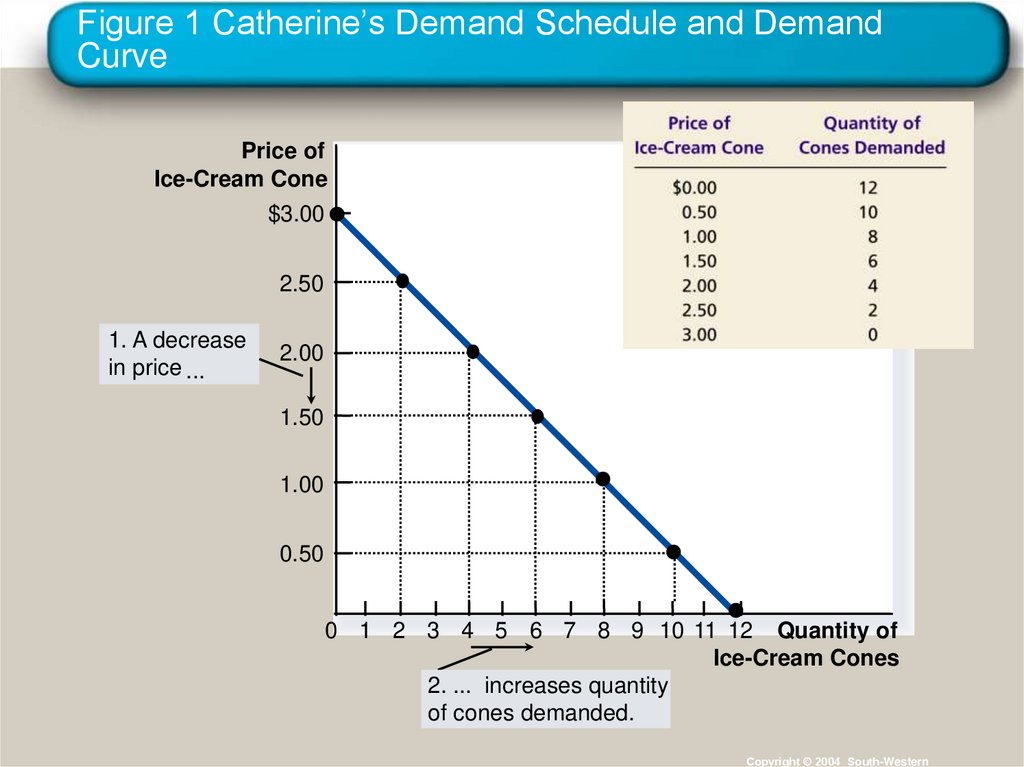
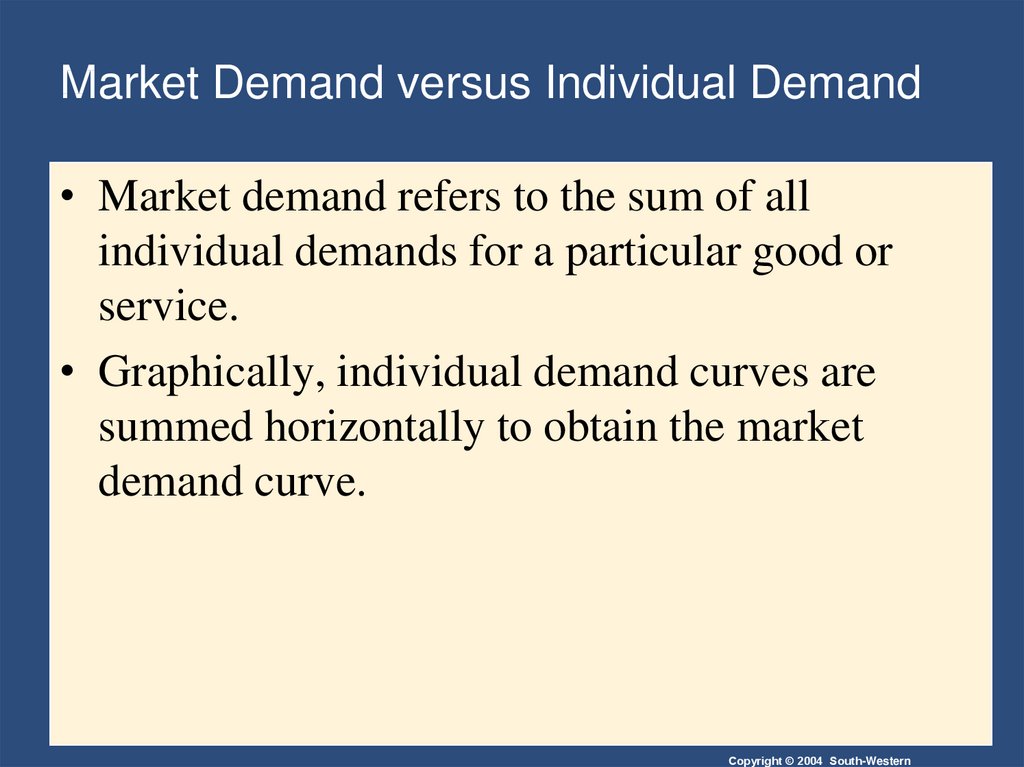
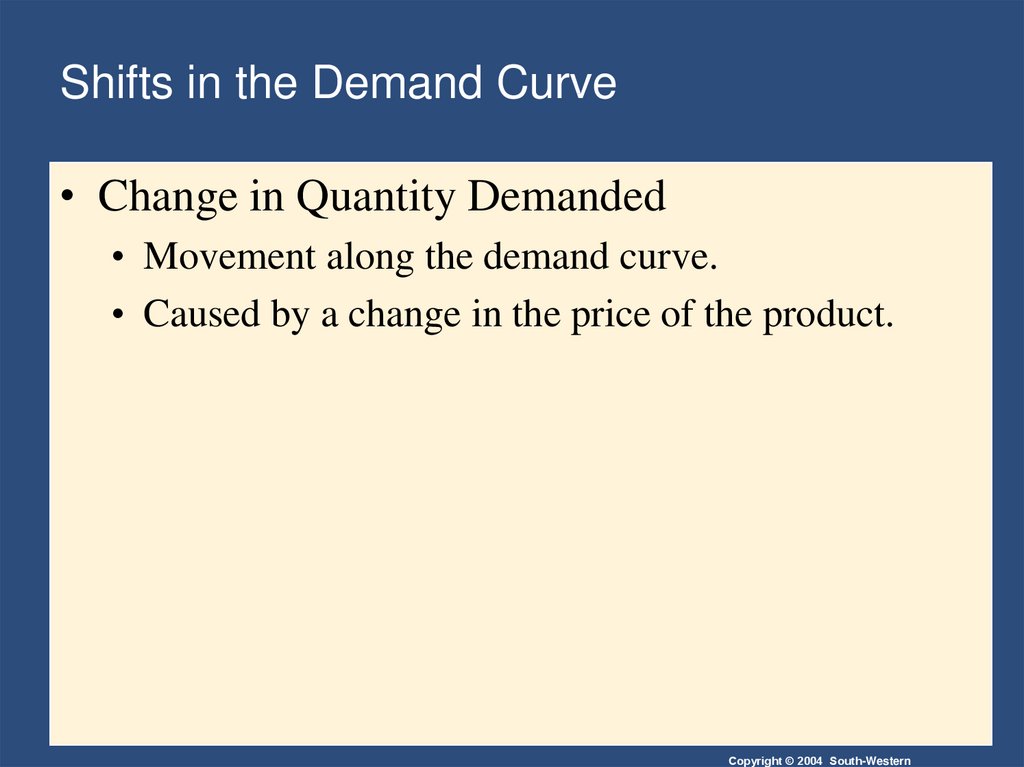
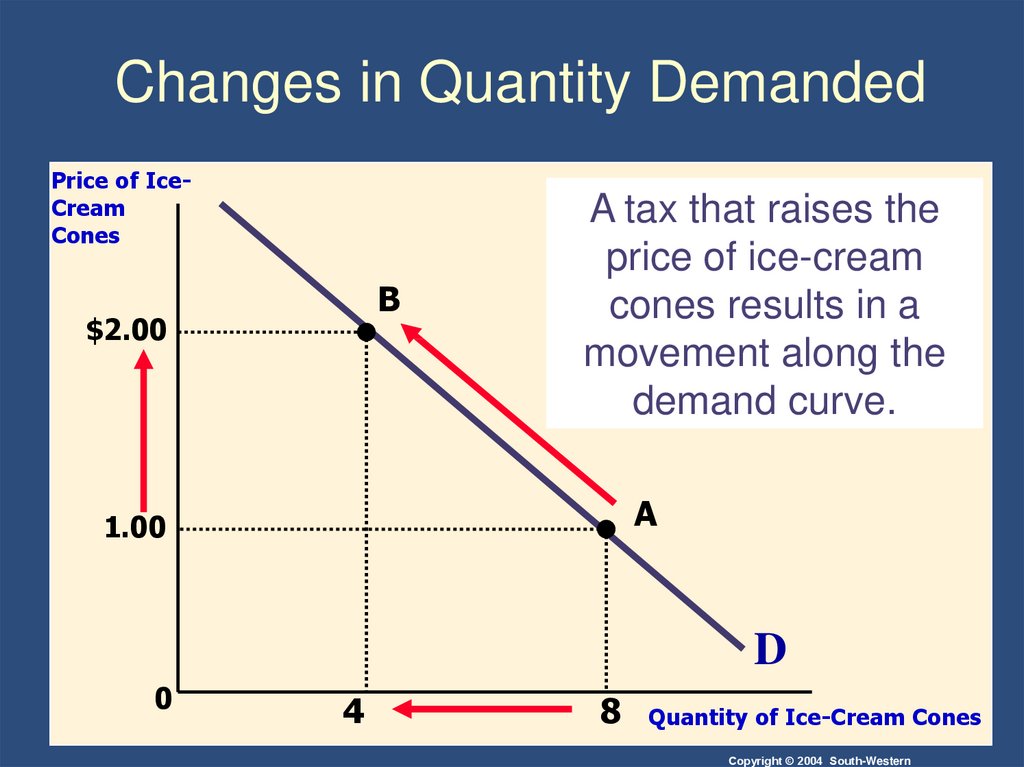
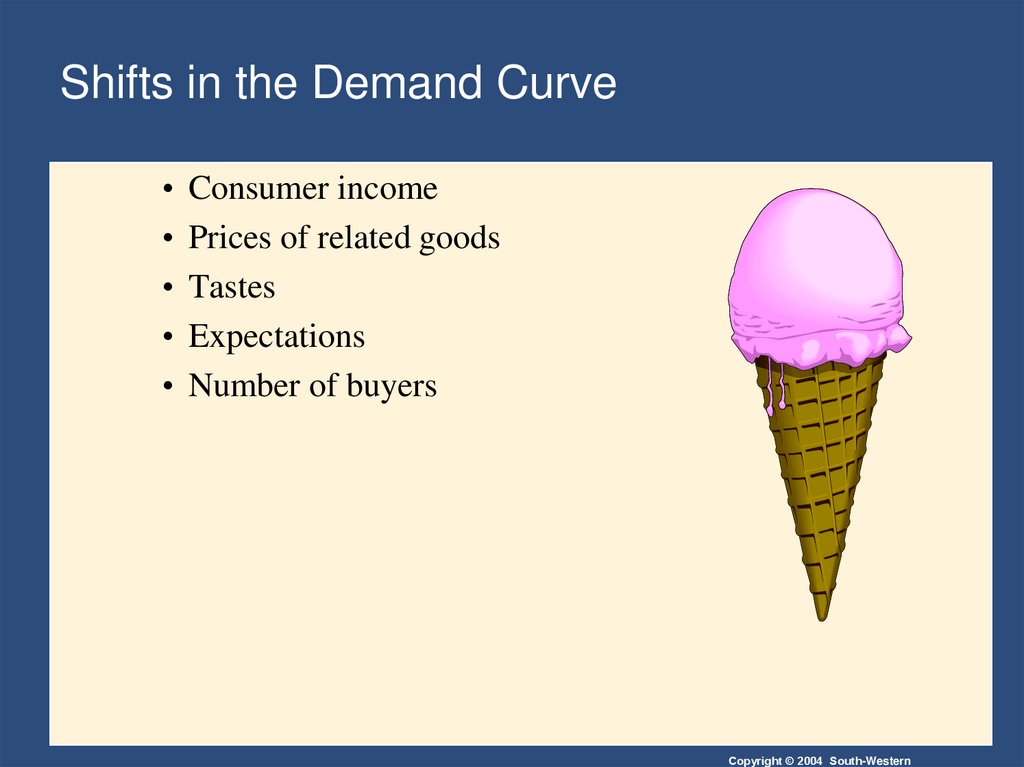
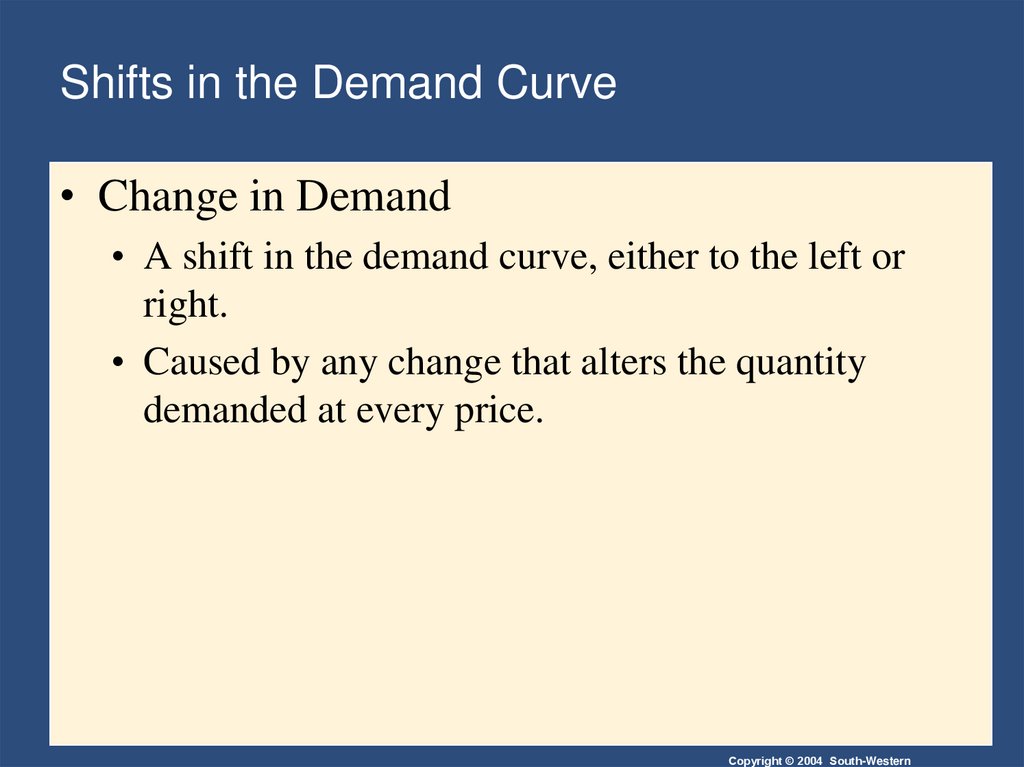
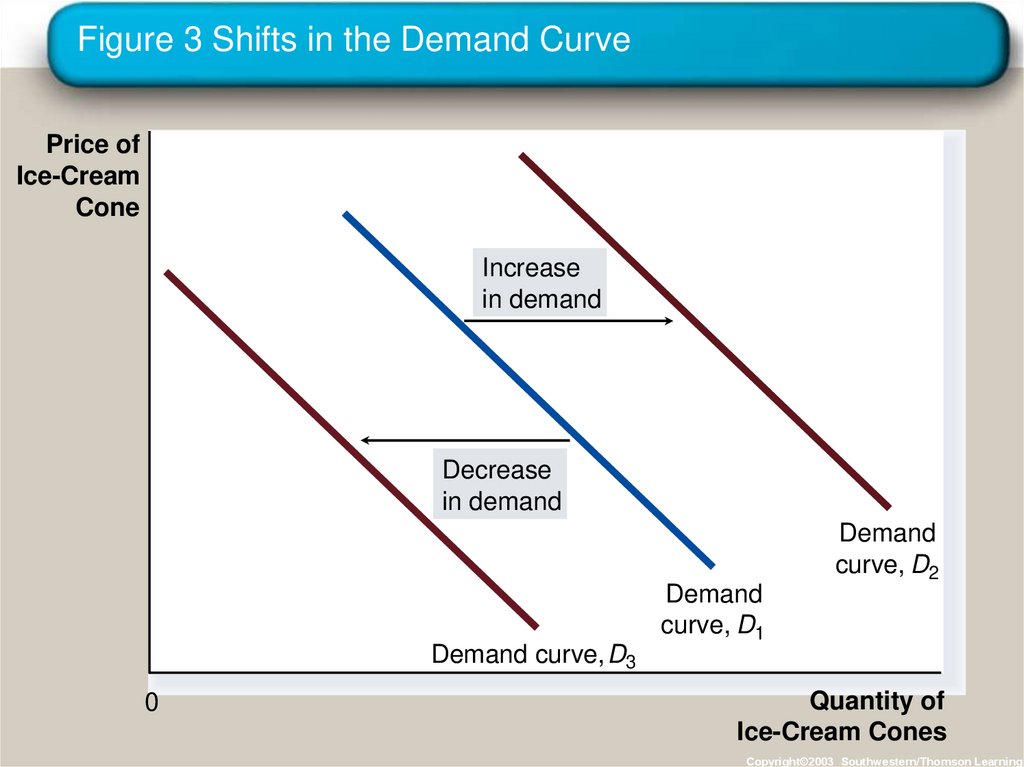
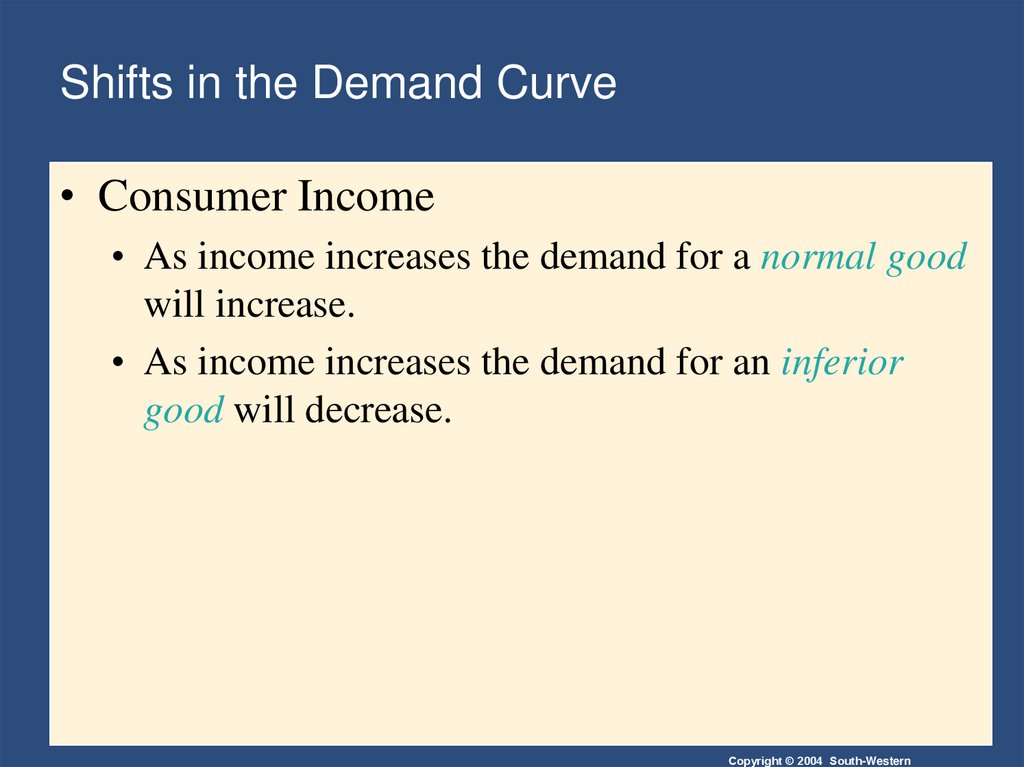
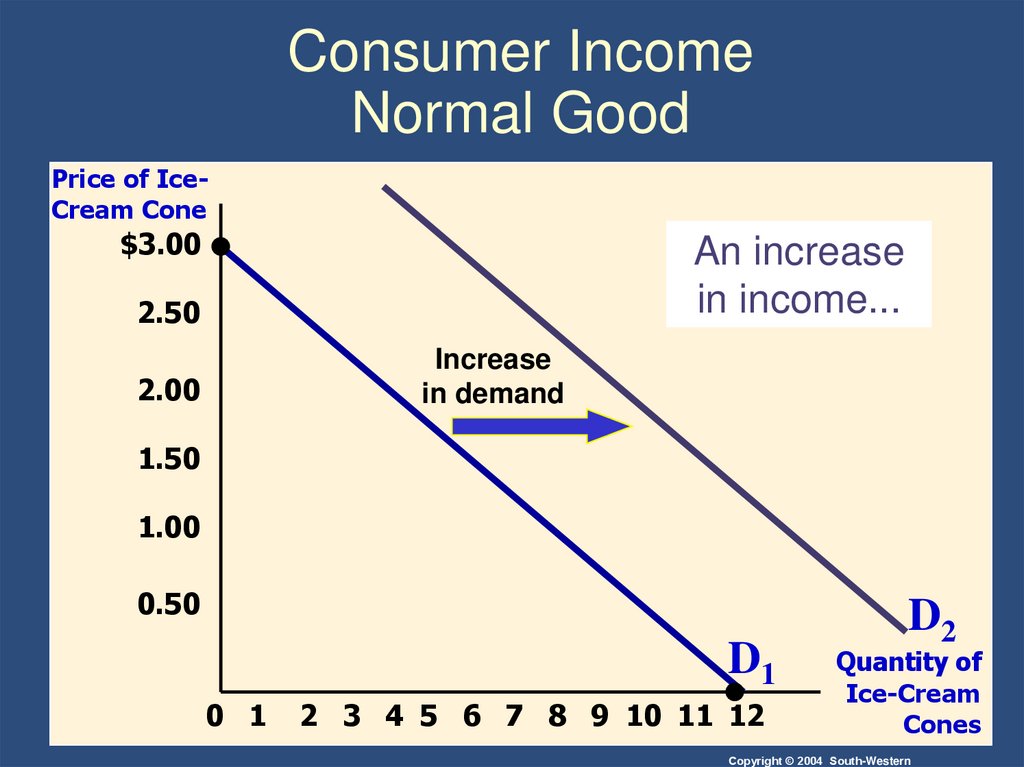
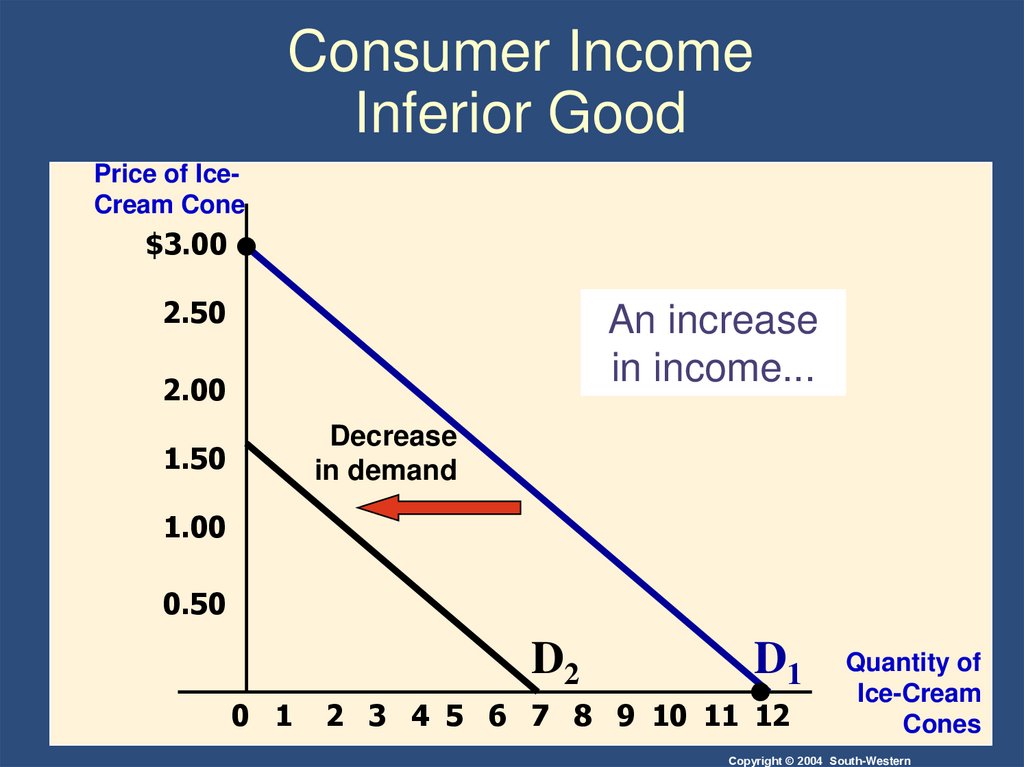
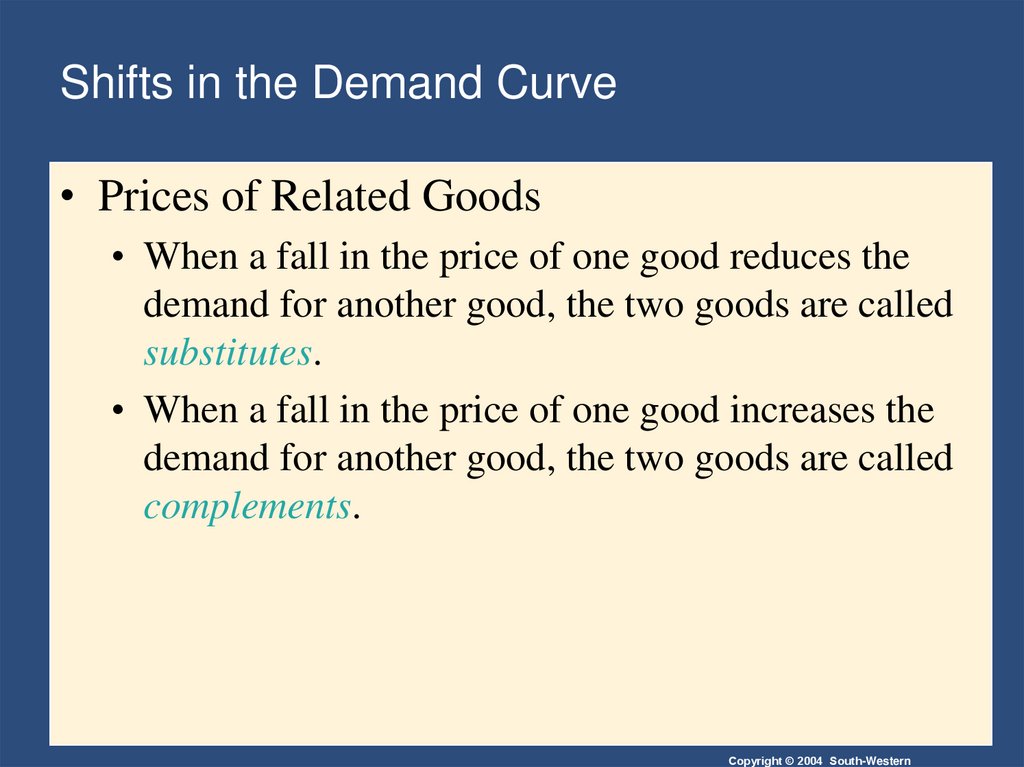
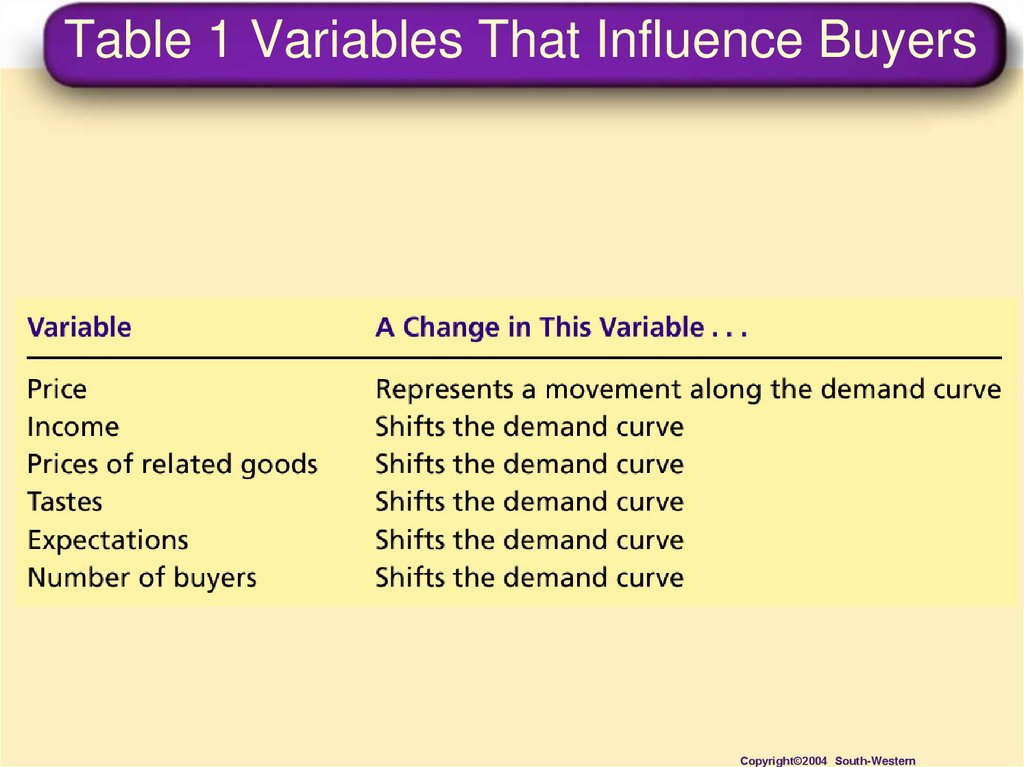
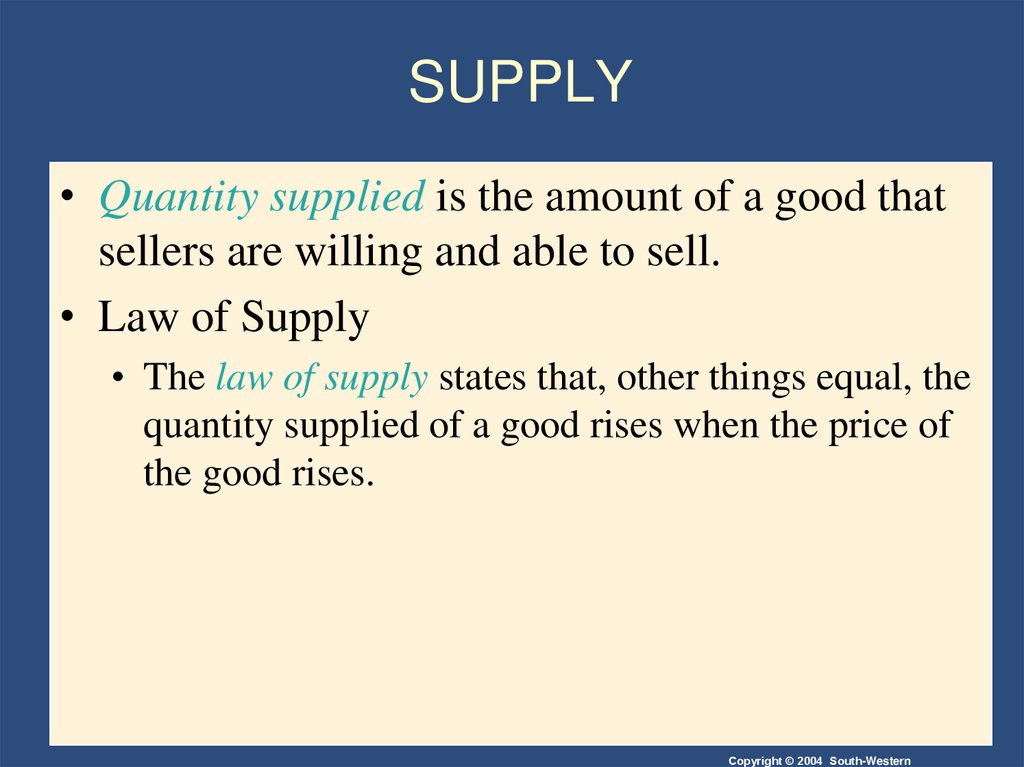
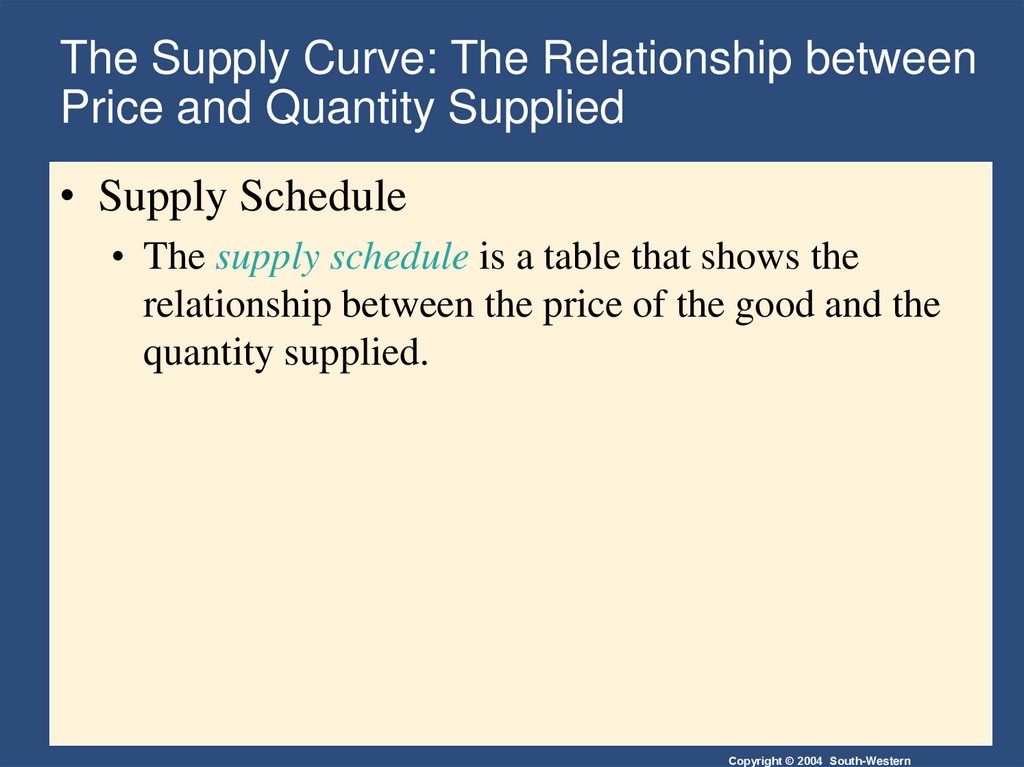
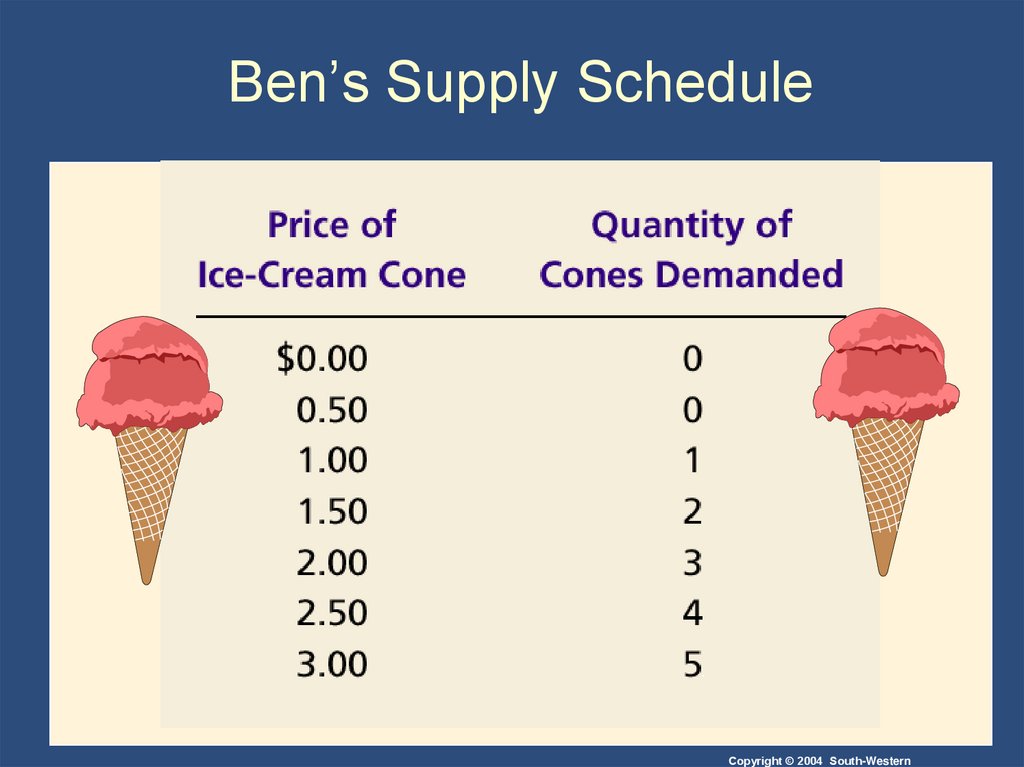
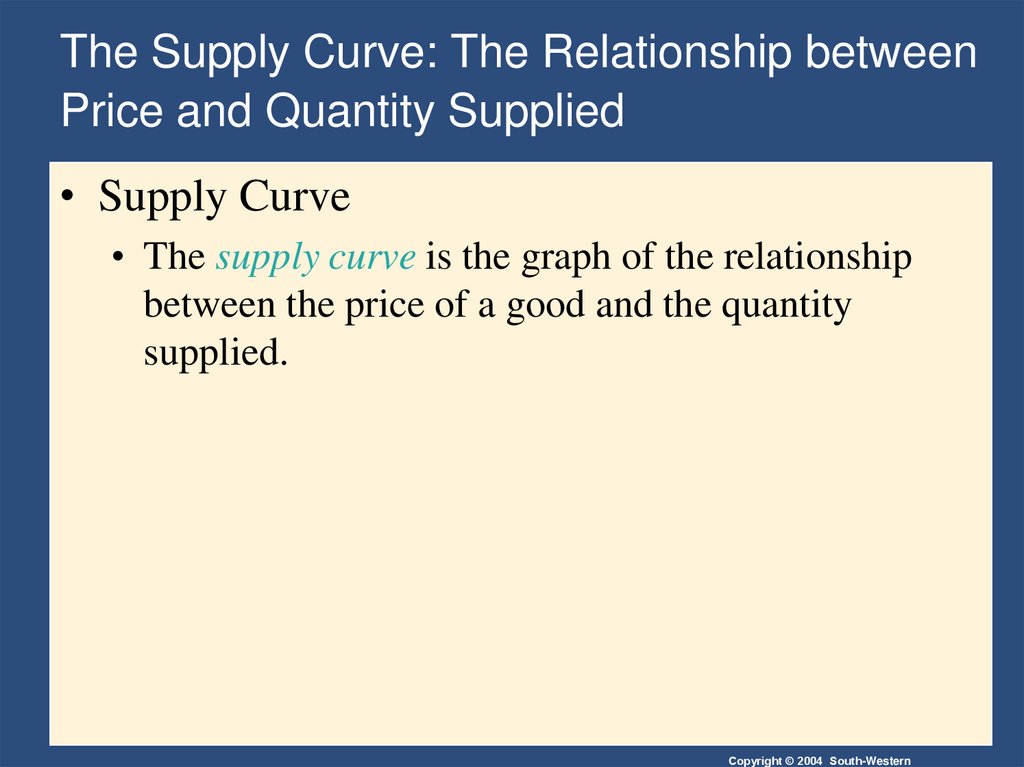

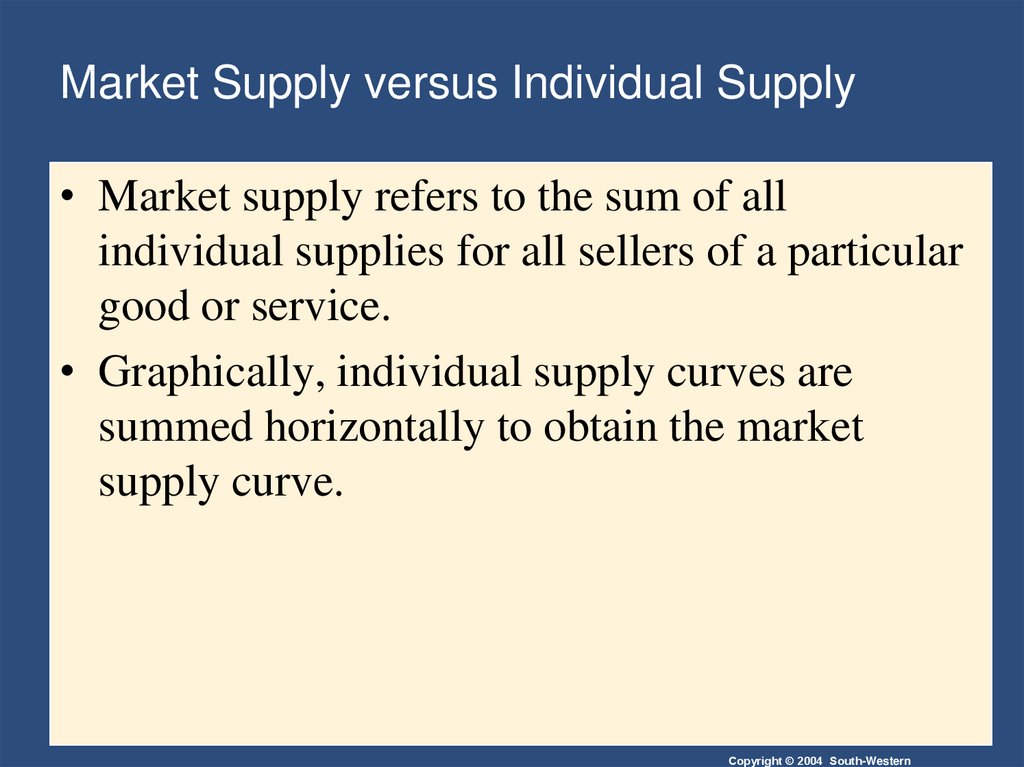
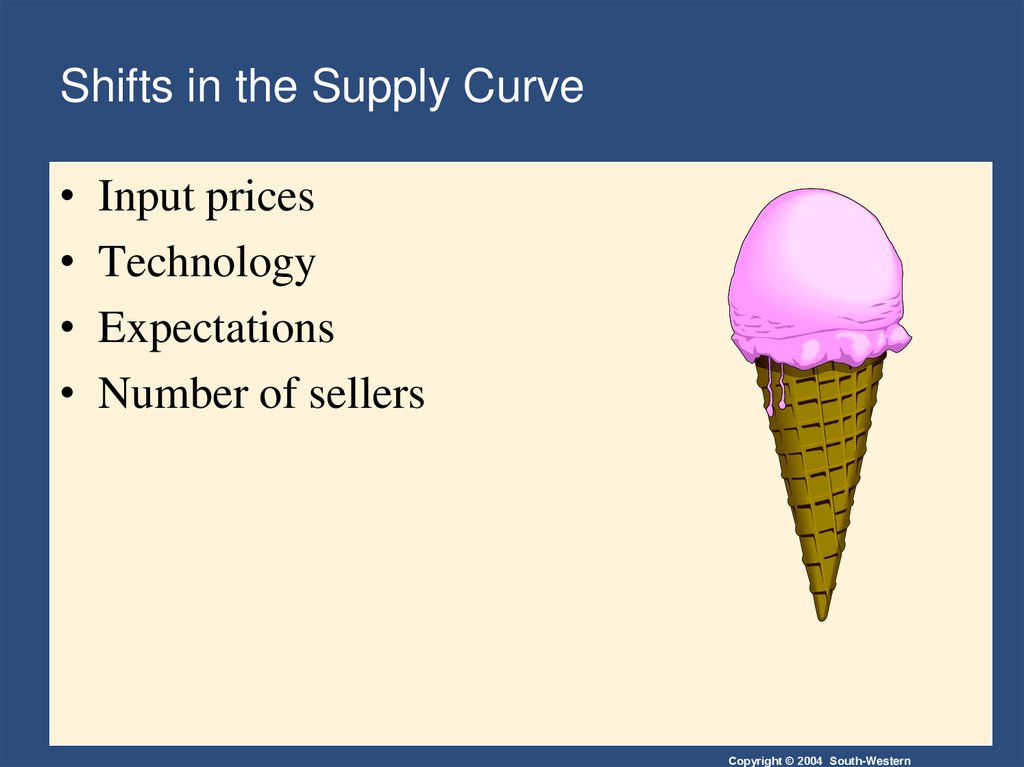

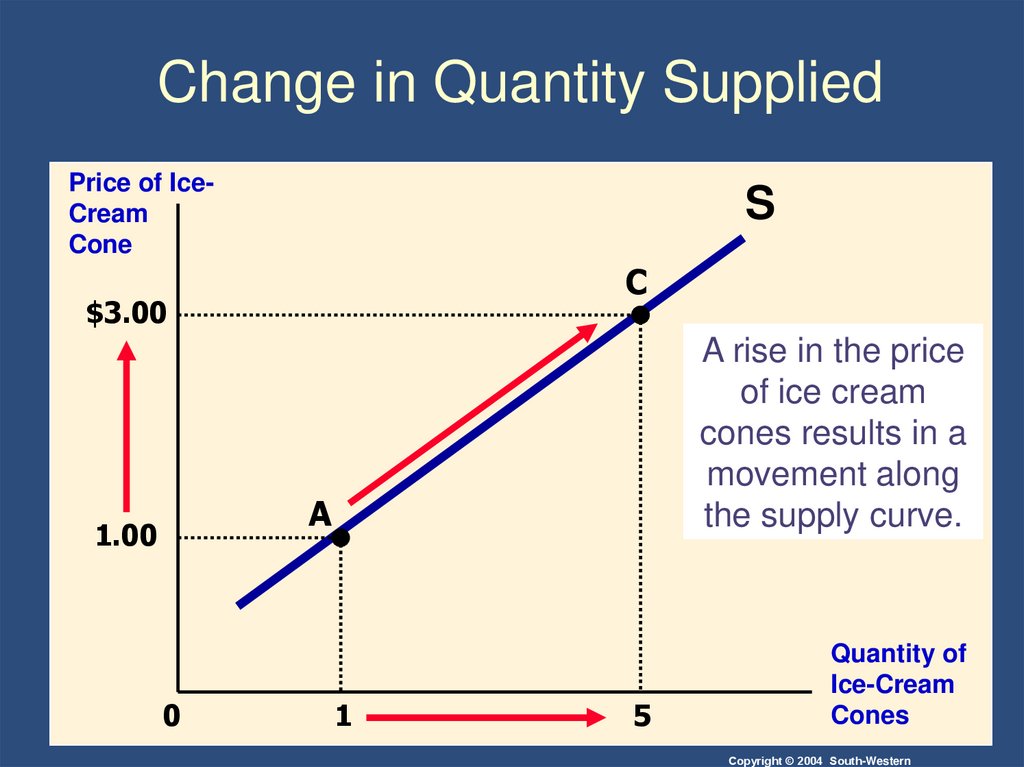
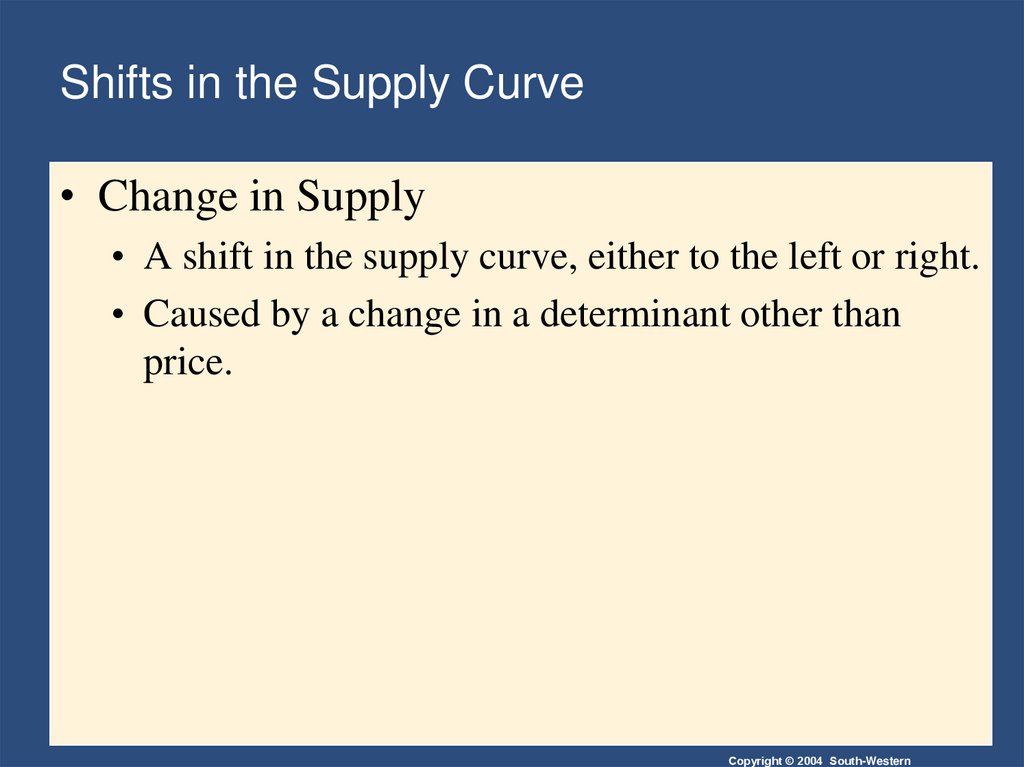
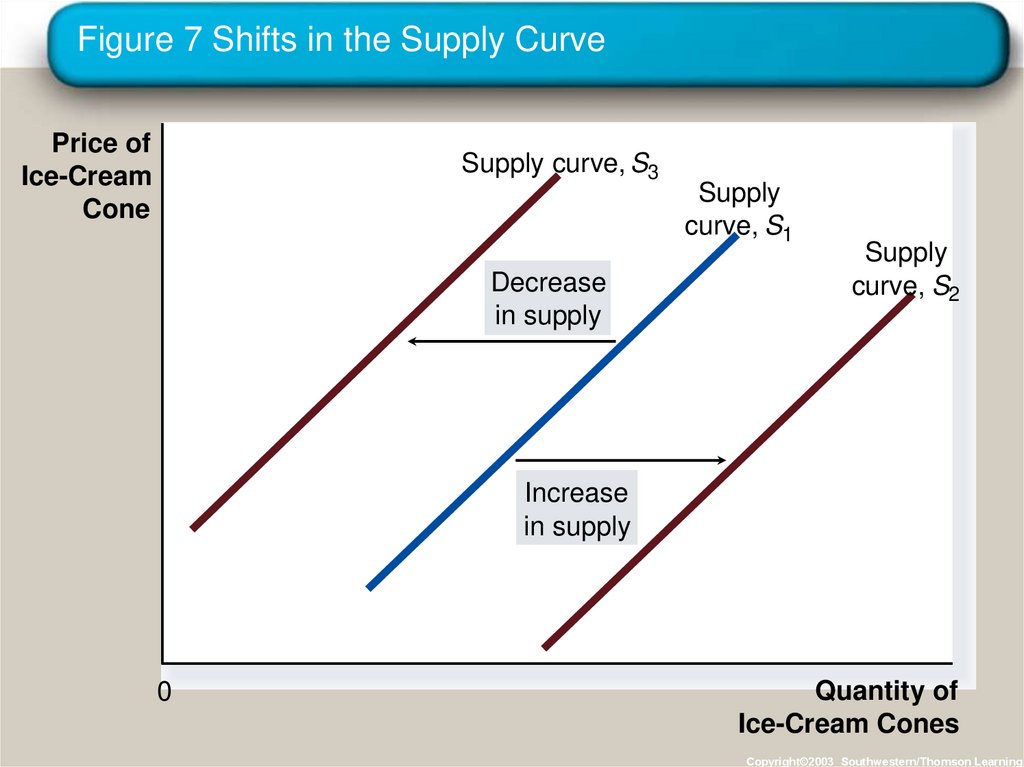
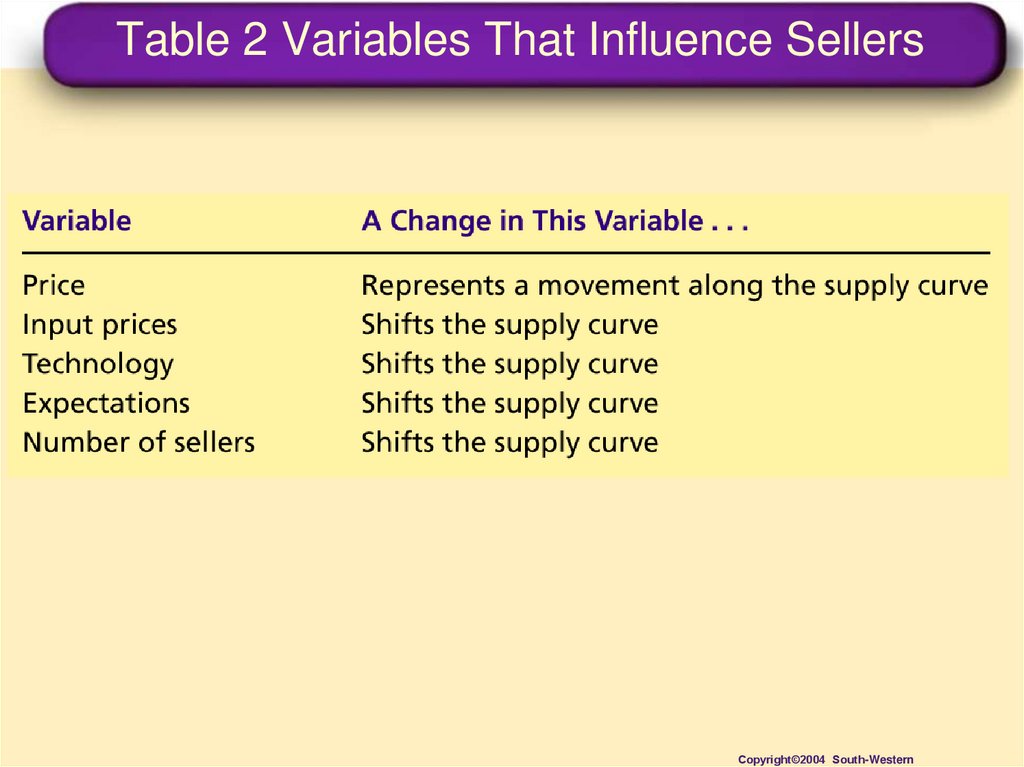
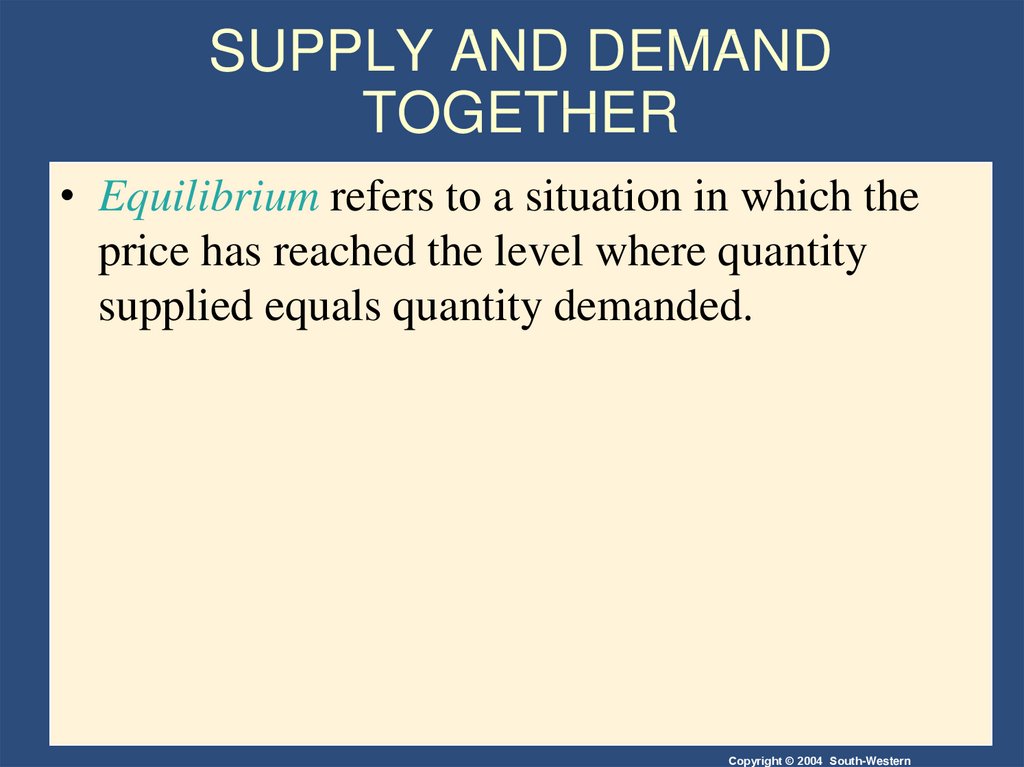
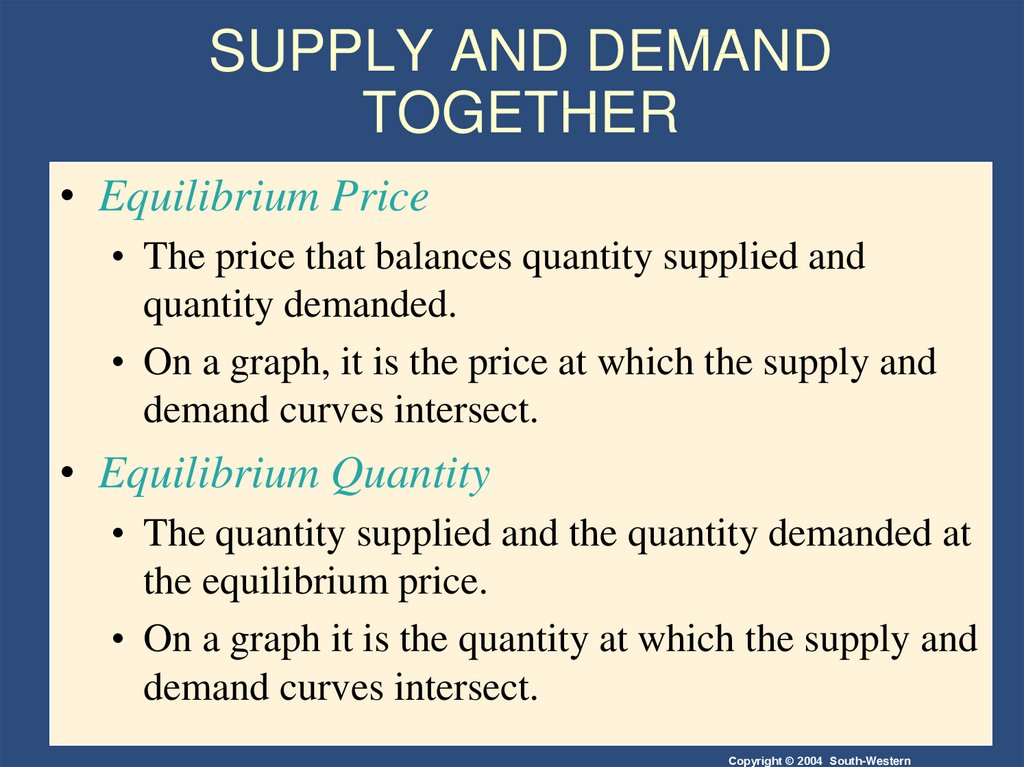
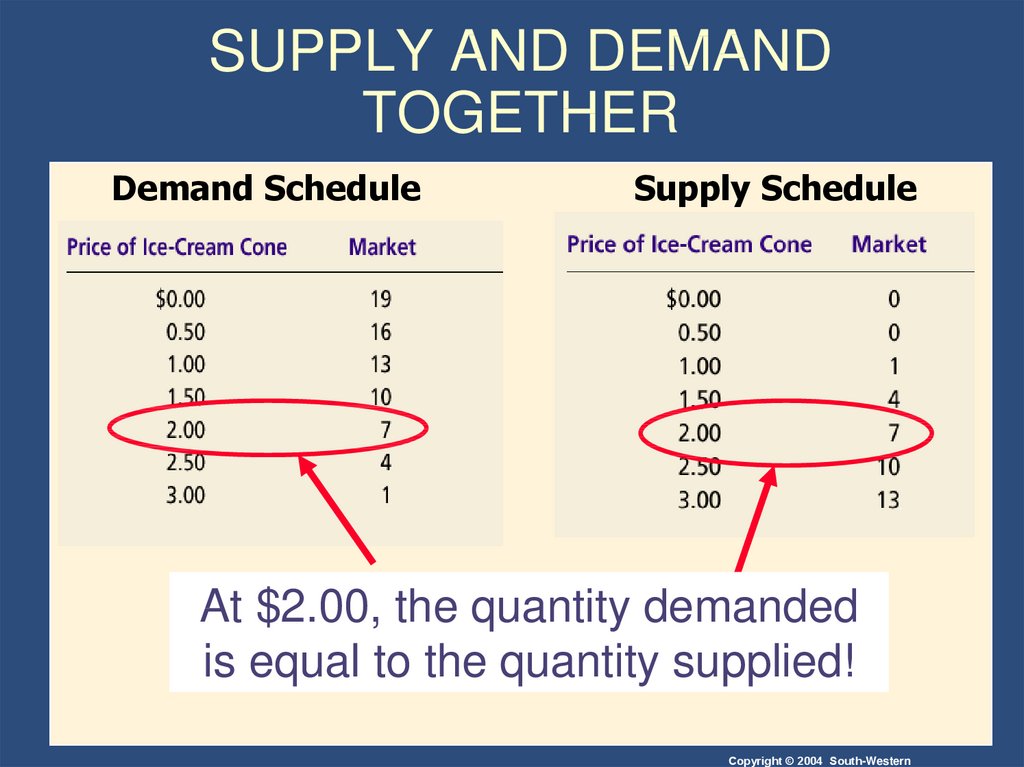
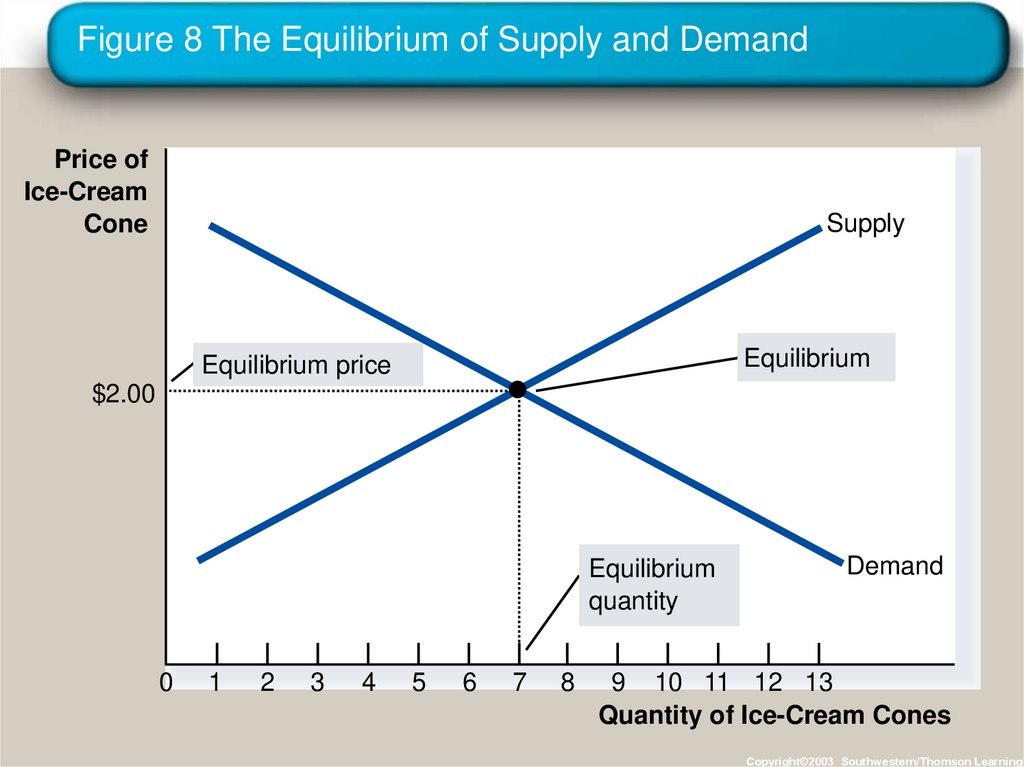
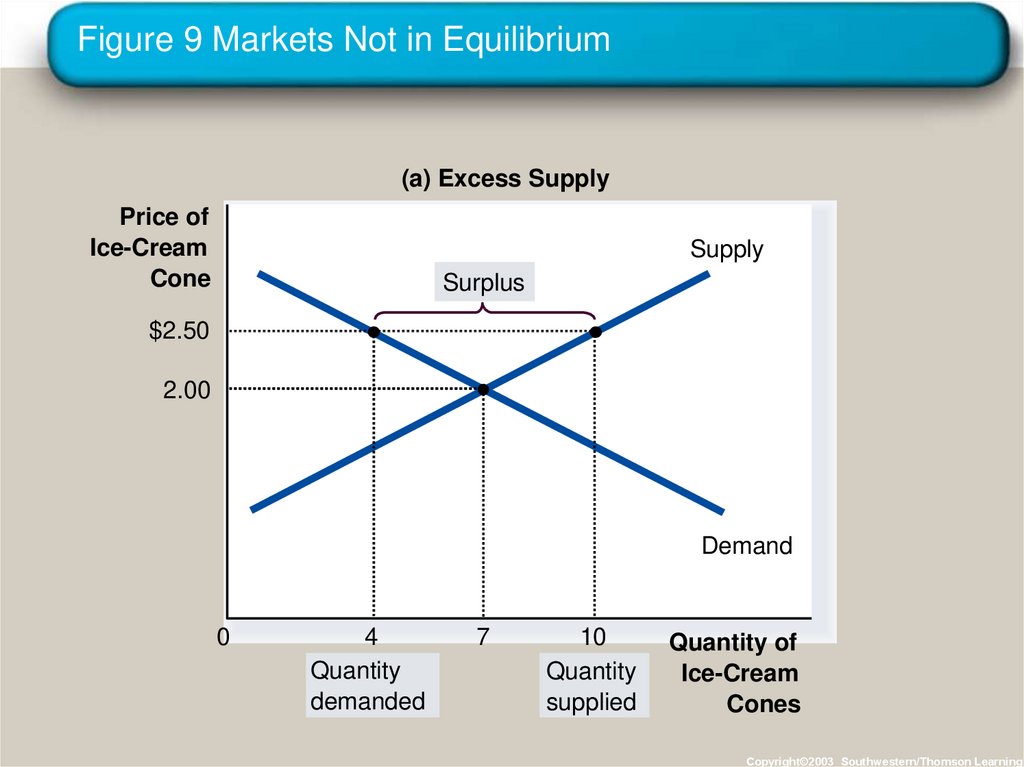
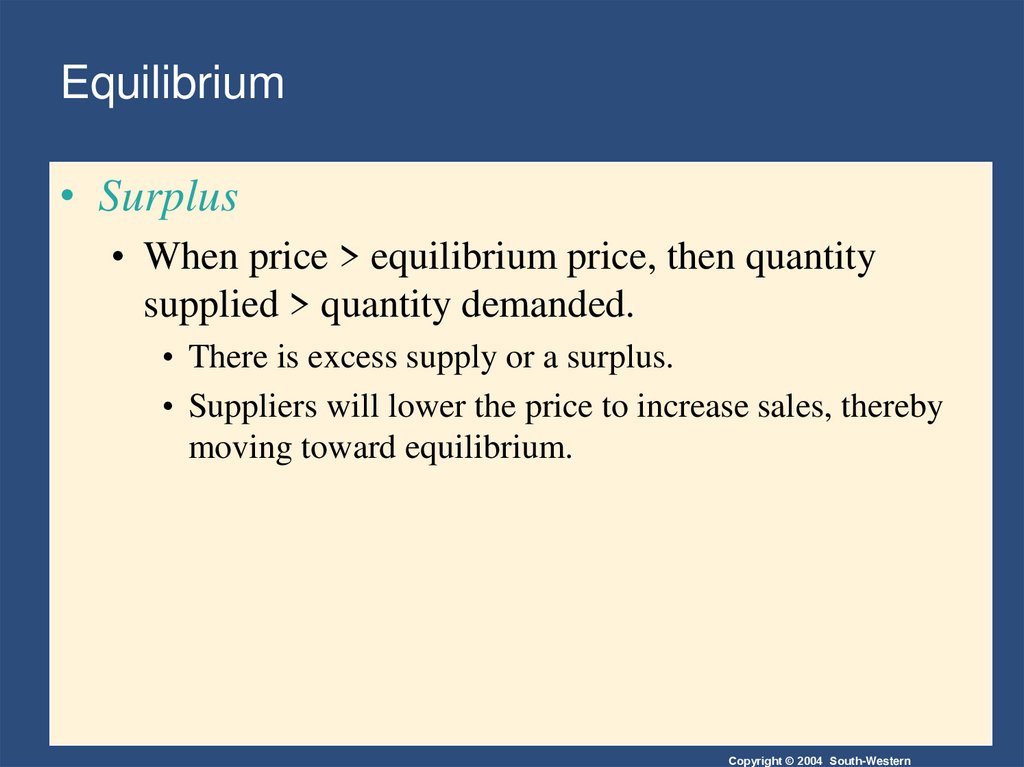
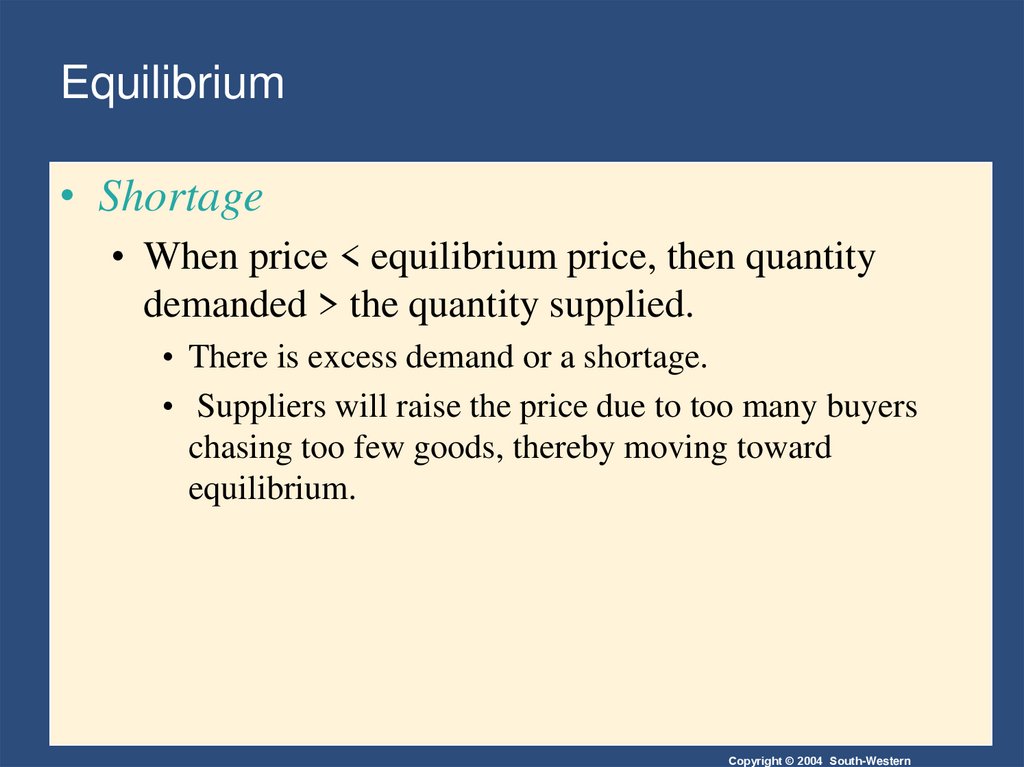
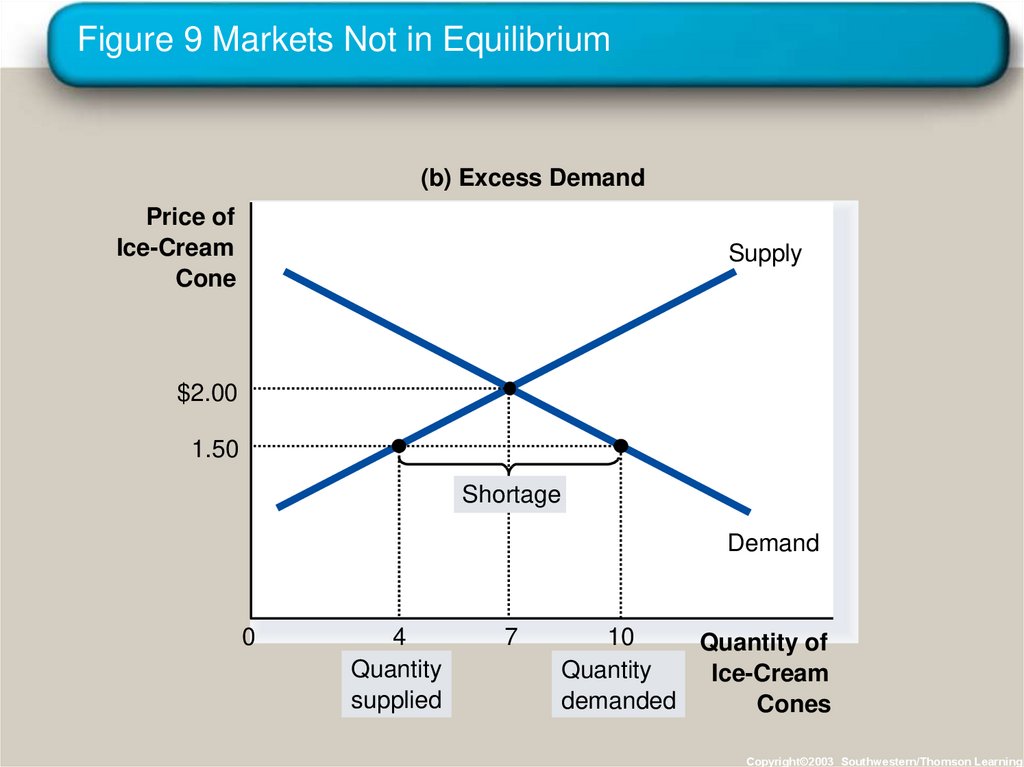
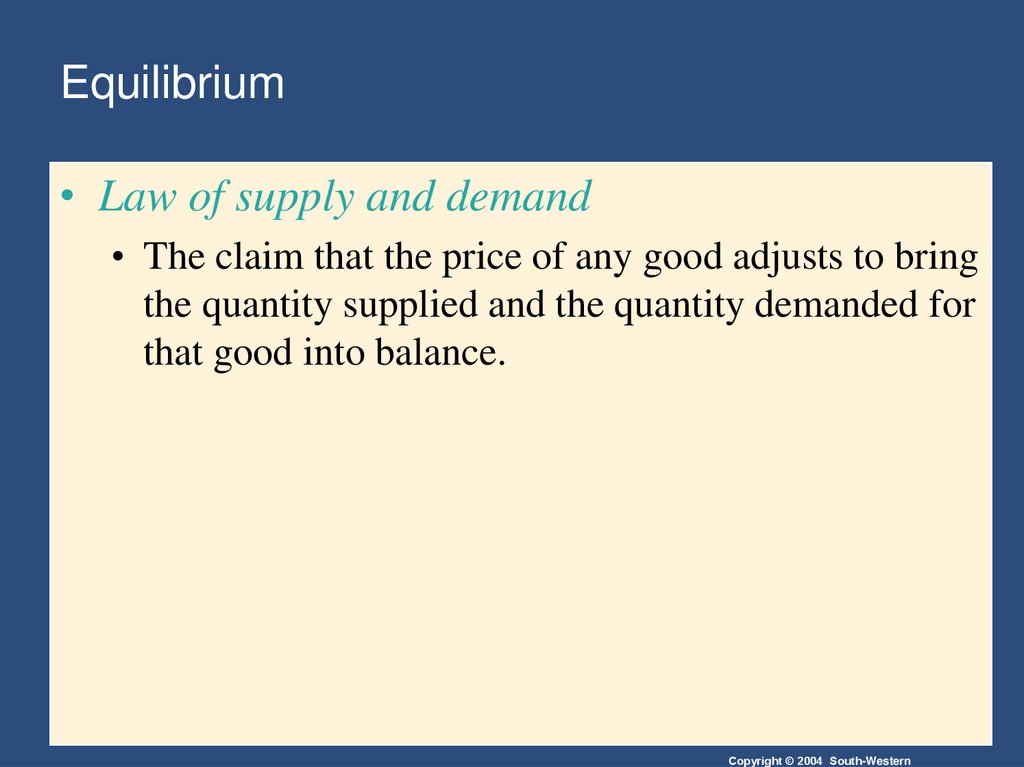
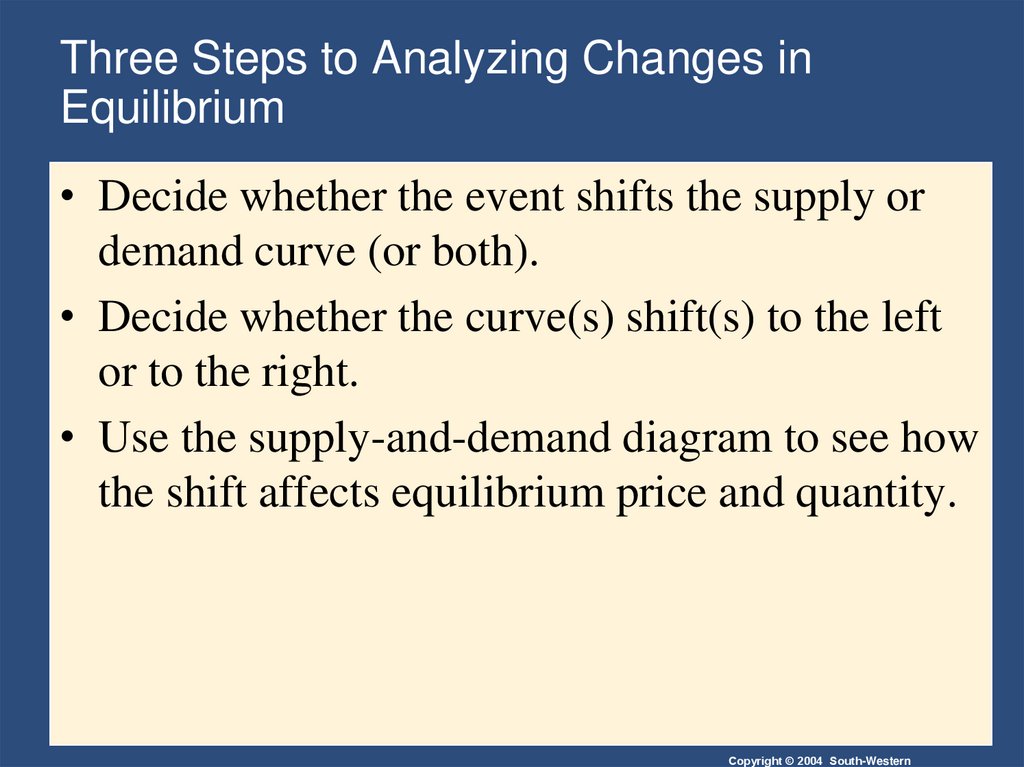
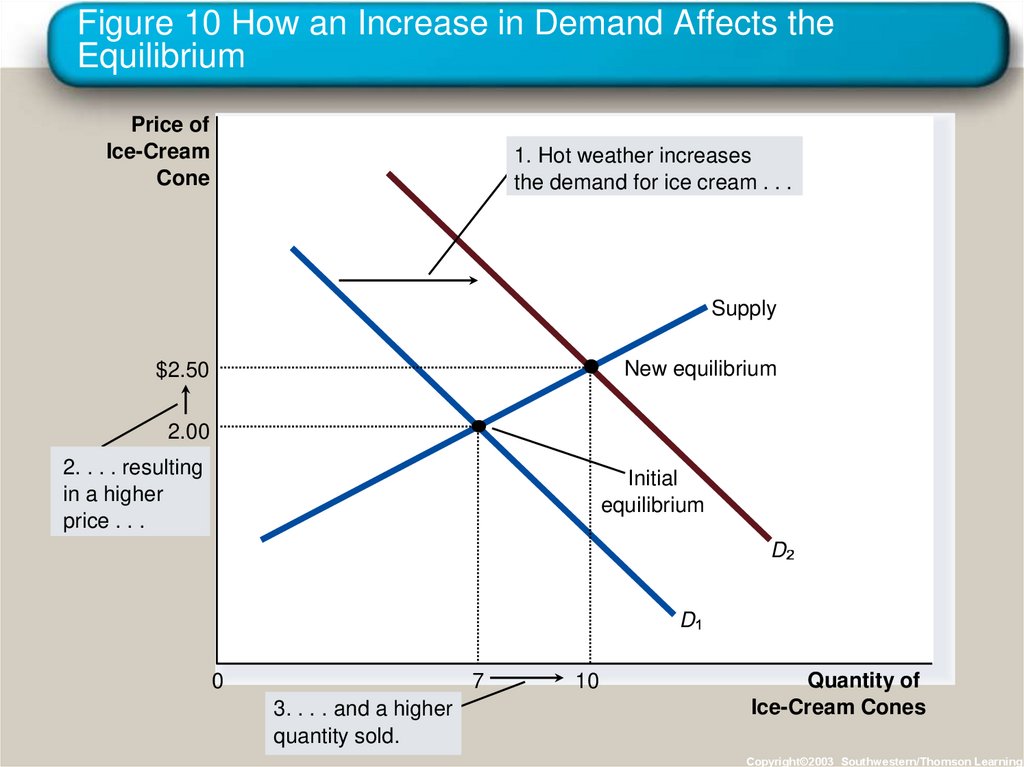
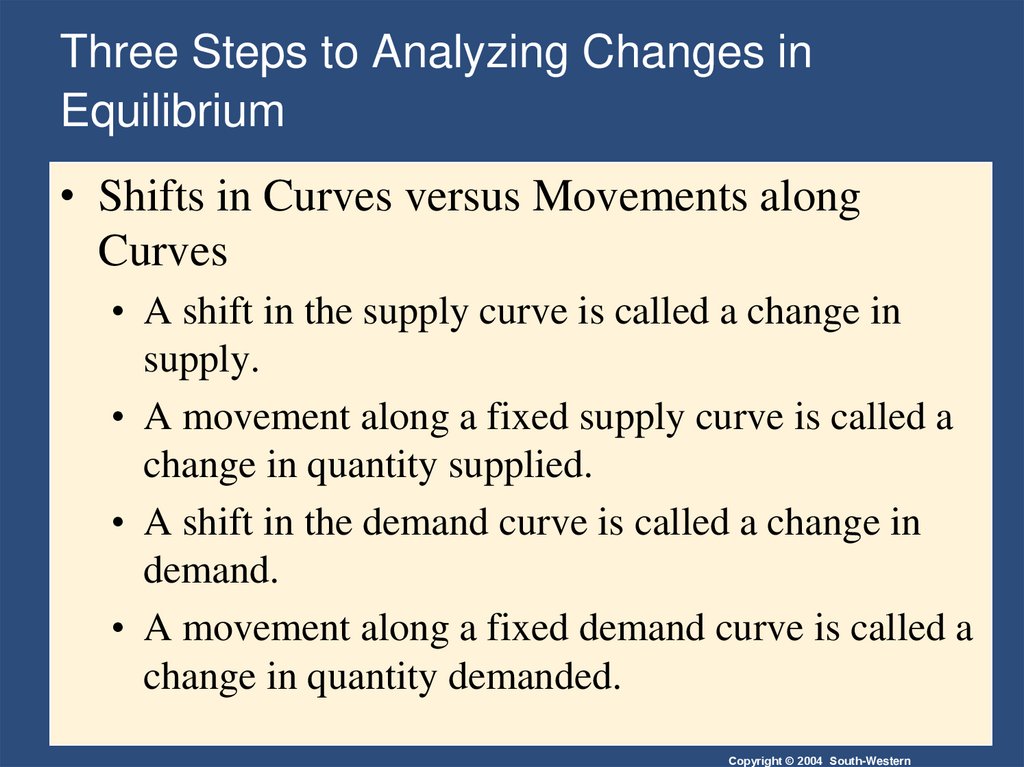
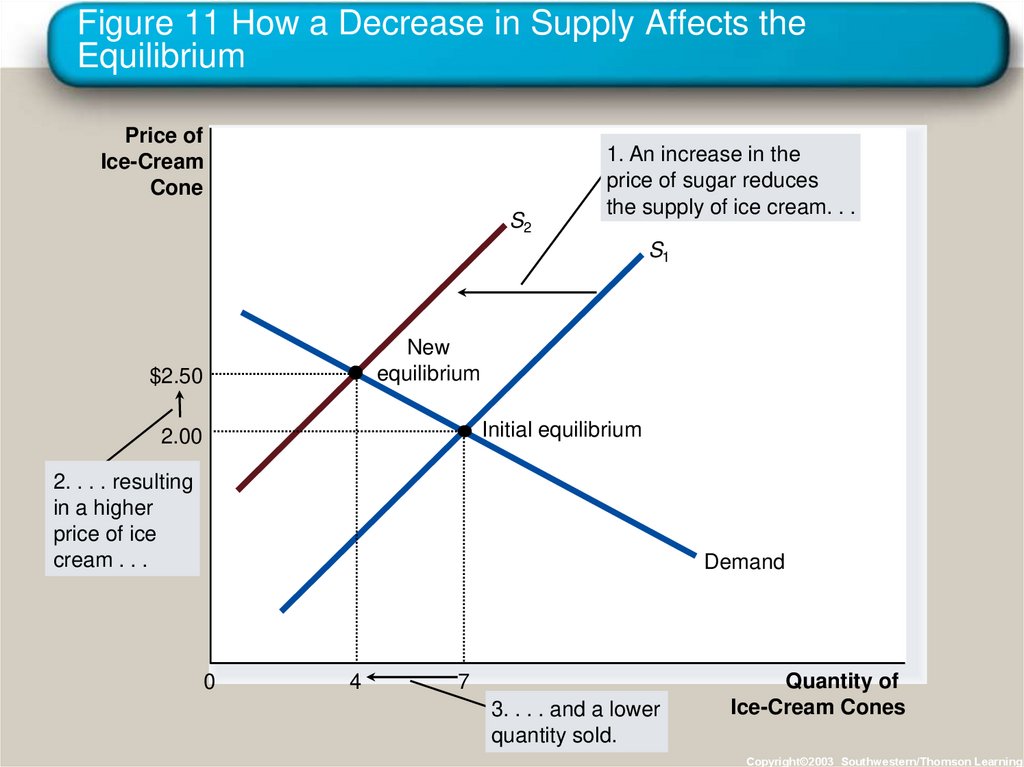

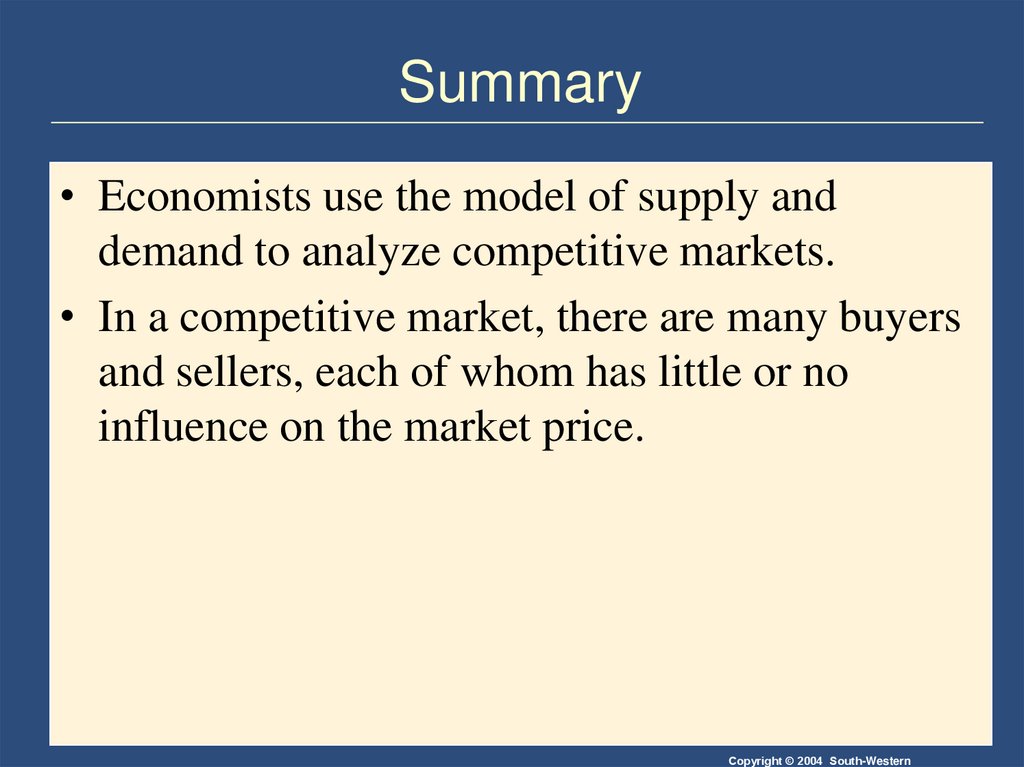
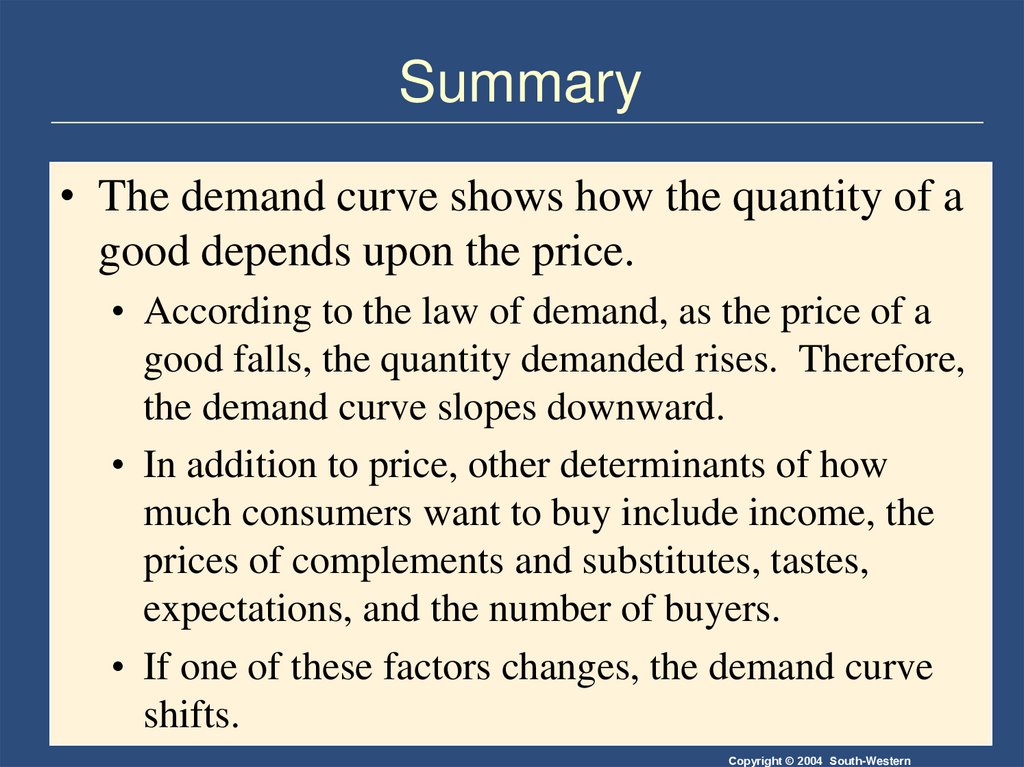
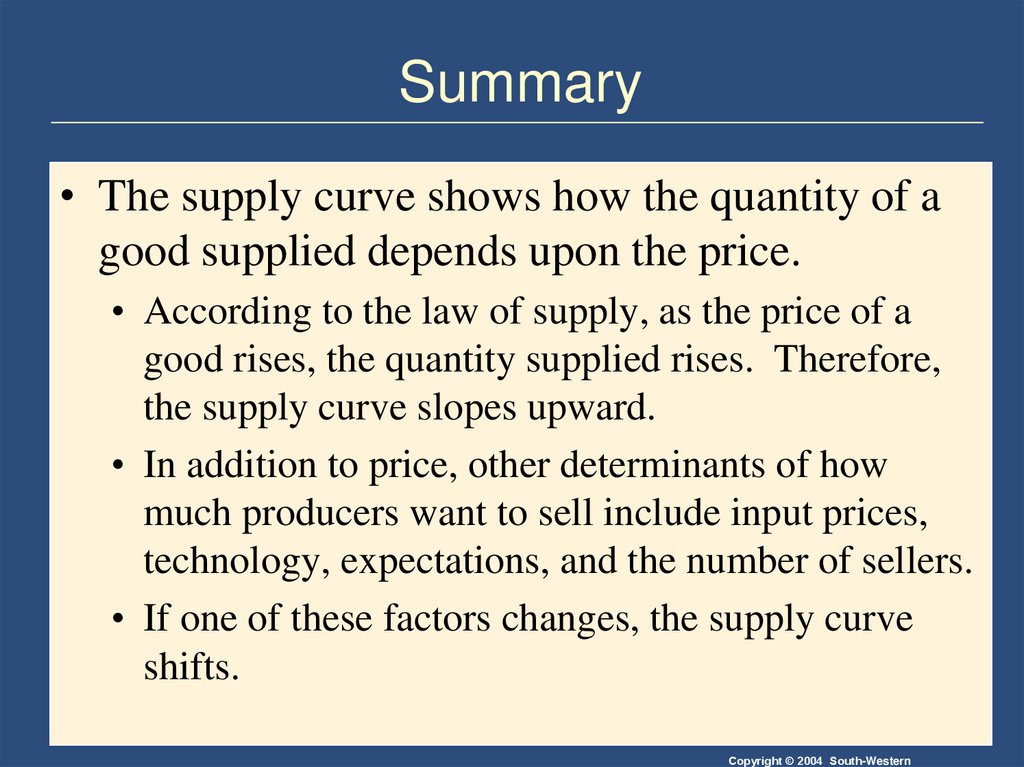
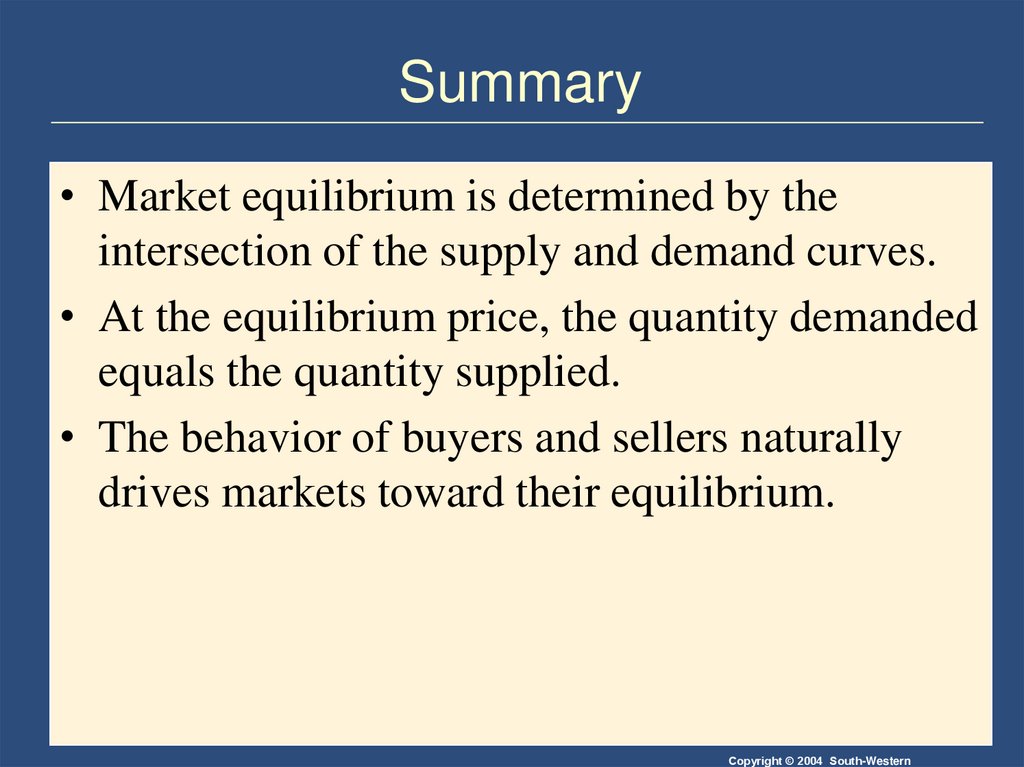
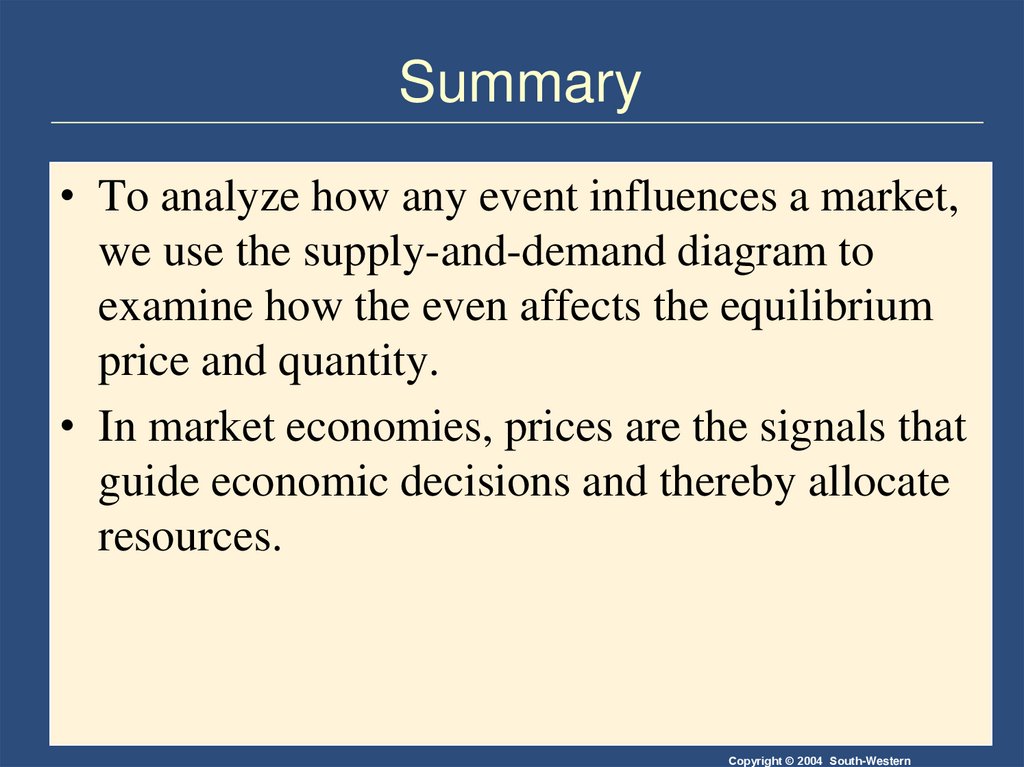
 economics
economics








